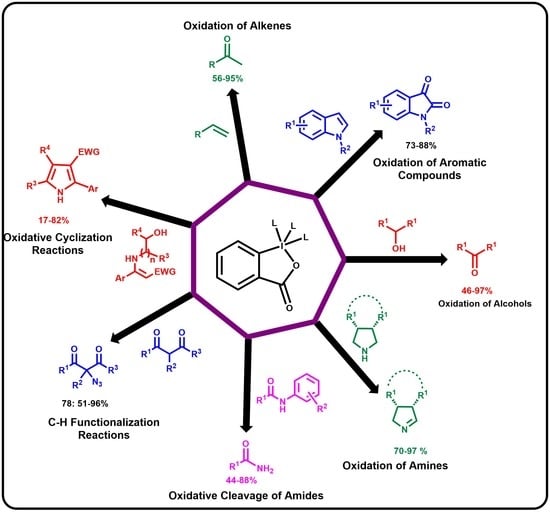Iodine(V)-Based Oxidants in Oxidation Reactions
Abstract
1. Introduction
2. Oxidation of Alcohols
3. Oxidation of Amines
4. Oxidative Cleavage of Amides
5. Oxidation of Alkenes
6. Oxidation of Aromatic Compounds
7. C−H Functionalization Reactions
8. Oxidative Cyclization Reactions
9. Miscellaneous Reactions
10. Conclusions
Author Contributions
Funding
Institutional Review Board Statement
Informed Consent Statement
Data Availability Statement
Acknowledgments
Conflicts of Interest
Sample Availability
References
- Wirth, T. (Ed.) Hypervalent Iodine Chemistry Modern Developments in Organic Synthesis; Springer: Berlin/Heidelberg, Germany, 2003. [Google Scholar]
- Zhdankin, V.V. Hypervalent Iodine Chemistry: Preparation, Structure, and Synthetic Applications of Polyvalent Iodine Compounds; Wiley: Chichester, UK, 2013; Volume I. [Google Scholar]
- Singh, F.V. Thomas Wirth, in Comprehensive Organic Synthesis II; Knochel, P., Molander, G., Eds.; Elsevier: Amsterdam, The Netherlands, 2014; p. 880. [Google Scholar]
- Singh, F.V.; Wirth, T. Science of Synthesis: Catalytic Oxidation in Organic Synthesis; Muñiz, K., Ed.; Thieme: Stuttgart, Germany, 2017; p. 29. [Google Scholar]
- Singh, F.V.; Wirth, T. The Chemistry of Hypervalent Halogen Compounds; Olofsson, B., Ilan, M., Zvi, R., Eds.; John Wiley & Sons, Ltd.: Chichester, UK, 2018; p. 809. [Google Scholar]
- Wang, Z. Innovation of hypervalent(III) iodine in the synthesis of natural products. New J. Chem. 2021, 45, 509–516. [Google Scholar] [CrossRef]
- Yoshimura, A.; Zhdankin, V.V. Advances in Synthetic Applications of Hypervalent Iodine Compounds. Chem. Rev. 2016, 116, 3328–3435. [Google Scholar] [CrossRef] [PubMed]
- Kumar, R.; Singh, F.V.; Takenaga, N.; Dohi, T. Asymmetric Direct/Stepwise Dearomatization Reactions Involving Hypervalent Iodine Reagents. Chem. Asian J. 2022, 17, e202101115. [Google Scholar] [CrossRef] [PubMed]
- Hyatt, F.D.; Dave, L.; David, N.; Kaur, K.; Medard, M.; Mowdawalla, C. Hypervalent iodine reactions utilized in carbon–carbon bond formations. Org. Biomol. Chem. 2019, 17, 7822–7848. [Google Scholar] [CrossRef] [PubMed]
- Shetgaonkar, S.E.; Singh, F.V. Hypervalent Iodine Reagents in Palladium-Catalyzed Oxidative Cross-Coupling Reactions. Front. Chem. 2020, 8, 705. [Google Scholar] [CrossRef] [PubMed]
- Shetgaonkar, S.E.; Mamgain, R.; Kikushima, K.; Dohi, T.; Singh, F.V. Palladium-Catalyzed Organic Reactions Involving Hypervalent Iodine Reagents. Molecules 2022, 27, 3900. [Google Scholar] [CrossRef] [PubMed]
- Yang, X.-G.; Hu, Z.-N.; Jia, M.-C.; Du, F.-H.; Zhang, C. Recent Advances and the Prospect of Hypervalent Iodine Chemistry. Synlett 2021, 32, 1289–1296. [Google Scholar] [CrossRef]
- Kokila, S.; Kole, P.B.; Mamgain, R.; Singh, F.V. Iodine(III)-Based Hypervalent Iodine Electrophiles in Organic Synthesis. Curr. Org. Chem. 2022, 26, 1917–1934. [Google Scholar] [CrossRef]
- Shetgaonkar, S.E.; Raju, A.; China, H.; Takenaga, N.; Dohi, T.; Singh, F.V. Non-Palladium-Catalyzed Oxidative Coupling Reactions Using Hypervalent Iodine Reagents. Front. Chem. 2022, 10, 909250. [Google Scholar] [CrossRef]
- Maiti, S.; Alam, M.T.; Bal, A.; Mal, P. Nitrenium Ions from Amine-Iodine(III) Combinations. Adv. Synth. Catal. 2019, 361, 4401–4425. [Google Scholar] [CrossRef]
- Zhdankin, V.V. Hypervalent iodine compounds: Reagents of the future. Arkivoc 2020, 2020, 1–11. [Google Scholar] [CrossRef]
- Singh, F.V.; Wirth, T. Selenium-Catalyzed Regioselective Cyclization of Unsaturated Carboxylic Acids Using Hypervalent Iodine Oxidants. Org. Lett. 2011, 13, 6504–6507. [Google Scholar] [CrossRef] [PubMed]
- Uyanik, M.; Ishihara, K. Hypervalent iodine-mediated oxidation of alcohols. Chem. Commun. 2009, 2086–2099. [Google Scholar] [CrossRef] [PubMed]
- Singh, F.V.; Mangaonkar, S.; Kole, P.B. Ultrasound-assisted rapid synthesis of β-cyanoepoxides using hypervalent iodine reagents. Synth. Commun. 2018, 48, 2169–2176. [Google Scholar] [CrossRef]
- Mangaonkar, S.R.; Kole, P.B.; Singh, F.V. Oxidation of Organosulfides to Organosulfones with Trifluoromethyl 3-Oxo-1λ3,2-benziodoxole-1(3H)-carboxylate as an Oxidant. Synlett 2018, 29, 199–202. [Google Scholar] [CrossRef]
- Singh, F.V.; Wirth, T. Hypervalent Iodine(III) Mediated Cyclization of ortho-Stillbenes into Benzofurans. Synthesis 2012, 44, 1171–1177. [Google Scholar] [CrossRef]
- Singh, F.V.; Kole, P.B.; Mangaonkar, S.R.; Shetgaonkar, S.E. Synthesis of spirocyclic scaffolds using hypervalent iodine reagent. Beilstein J. Org. Chem. 2018, 14, 1778–1805. [Google Scholar] [CrossRef]
- Shetgaonkar, S.E.; Singh, F.V. Hypervalent iodine-mediated synthesis and late-stage functionalization of heterocycles. Arkivoc 2020, 2020, 86–161. [Google Scholar] [CrossRef]
- Singh, F.V.; Rehbein, J.; Wirth, T. Facile Oxidative Rearrangements Using Hypervalent Iodine Reagents. ChemistryOpen 2012, 1, 245–250. [Google Scholar] [CrossRef]
- Singh, F.V.; Wirth, T. Oxidative rearrangements with hypervalent iodine reagents. Synthesis 2013, 45, 2499–2511. [Google Scholar] [CrossRef]
- Shetgaonkar, S.E.; Krishnan, M.; Singh, F.V. Hypervalent Iodine Reagents for Oxidative Rearrangements. Mini Rev. Org. Chem. 2021, 18, 138. [Google Scholar] [CrossRef]
- Merritt, E.A.; Olofsson, B. α-Functionalization of carbonyl compounds using hypervalent iodine reagents. Synthesis 2011, 4, 517–538. [Google Scholar] [CrossRef]
- Dong, D.-Q.; Hao, S.-H.; Wang, Z.-L.; Chen, C. Hypervalent iodine: A powerful electrophile for asymmetric α-functionalization of carbonyl compounds. Org. Biomol. Chem. 2014, 12, 4278–4289. [Google Scholar] [CrossRef]
- Li, Y.; Hari, D.P.; Vita, M.V.; Waser, J. Cyclic hypervalent iodine reagents for atom-transfer reactions: Beyond trifluoromethylation. Angew. Chem. Int. Ed. 2016, 55, 4436–4454. [Google Scholar] [CrossRef] [PubMed]
- Li, X.; Chen, P.; Liu, G. Recent advances in hypervalent iodine(III)-catalyzed functionalization of alkenes. Beilstein J. Org. Chem. 2018, 14, 1813–1825. [Google Scholar] [CrossRef]
- Lee, J.H.; Choi, S.; Hong, K.B. Alkene Difunctionalization Using Hypervalent Iodine Reagents: Progress and Developments in the Past Ten Years. Molecules 2019, 24, 2634. [Google Scholar] [CrossRef] [PubMed]
- Singh, F.V.; Wirth, T. Hypervalent iodine-catalyzed oxidative functionalizations including stereoselective reactions. Chem. Asian J. 2014, 9, 950–971. [Google Scholar] [CrossRef] [PubMed]
- Singh, F.V.; Mangaonkar, S.R. Hypervalent Iodine(III)-Catalyzed Synthesis of 2-Arylbenzofurans. Synthesis 2018, 50, 4940–4948. [Google Scholar] [CrossRef]
- Mangaonkar, S.R.; Singh, F.V. Hypervalent Iodine(III)-Catalyzed Epoxidation of β-Cyanostyrenes. Synthesis 2019, 51, 4473–4486. [Google Scholar] [CrossRef]
- Mangaonkar, S.R.; Shetgaonkar, S.E.; Vernekar, A.; Singh, F.V. Ultrasonic-Assisted Hypervalent Iodine-Catalyzed Cyclization of (E)-2-Hydroxystilbenes to Benzofurans Using Iodobenzene as Pre-catalyst. ChemistrySelect 2020, 5, 10754–10758. [Google Scholar] [CrossRef]
- Dohi, T.; Kita, Y. Iodine Catalysis in Organic Synthesis; Ishihara, K., Muñiz, K., Eds.; John Wiley & Sons, Ltd.: Chichester, UK, 2022; p. 211. [Google Scholar]
- Singh, F.V.; Shetgaonkar, S.E.; Krishnan, M.; Wirth, T. Progress in organocatalysis with hypervalent iodine catalysts. Chem. Soc. Rev. 2022, 51, 8102–8139. [Google Scholar] [CrossRef] [PubMed]
- Antonchick, A.P.; Narayan, R.; Manna, S. Hypervalent Iodine(III) in Direct Carbon–Hydrogen Bond Functionalization. Synlett 2015, 26, 1785–1803. [Google Scholar] [CrossRef]
- Parra, A. Chiral Hypervalent Iodines: Active Players in Asymmetric Synthesis. Chem. Rev. 2019, 119, 12033–12088. [Google Scholar] [CrossRef] [PubMed]
- Shetgaonkar, S.E.; Singh, F.V. Catalytic stereoselective synthesis involving hypervalent iodine-based chiral auxiliaries. Org. Biomol. Chem. 2023, 21, 4163–4180. [Google Scholar] [CrossRef]
- Singh, F.V.; Wirth, T. Hypervalent iodine chemistry and light: Photochemical reactions involving hypervalent iodine Chemistry. Arkivoc 2021, 2021, 12–47. [Google Scholar] [CrossRef]
- Chen, C.; Wang, X.; Yang, T. Recent Synthetic Applications of the Hypervalent Iodine(III) Reagents in Visible-Light-Induced Photoredox Catalysis. Front. Chem. 2020, 8, 551159. [Google Scholar] [CrossRef]
- Ladziata, U.; Zhdankin, V.V. Hypervalent iodine(V) reagents in organic synthesis. Arkivoc 2006, 2006, 26–58. [Google Scholar] [CrossRef]
- Zhdankin, V.V. Organoiodine(V) Reagents in Organic Synthesis. J. Org. Chem. 2011, 76, 1185–1197. [Google Scholar] [CrossRef]
- Hartman, C.; Mayer, V. Ueber Jodobenzoësäure. Chem. Ber. 1893, 26, 1727–1732. [Google Scholar] [CrossRef]
- Boeckman, R.K.; Shao, P.; Mullins, J. The Dess-Martin Periodinane: 1,1,1-Triacetoxy-1,1-Dihydro-1,2-Benziodoxol-3(1H)-One. J. Org. Synth. 2000, 77, 141. [Google Scholar] [CrossRef]
- Frigerio, M.; Santagostino, M.; Sputore, S. A User-Friendly Entry to 2-Iodoxybenzoic Acid (IBX). J. Org. Chem. 1999, 64, 4537–4538. [Google Scholar] [CrossRef]
- Nageswar, Y.V.D.; Ramesh, K.; Rakhi, K. IBX-Mediated Organic Transformations in Heterocyclic Chemistry-A Decade Update. Front. Chem. 2022, 10, 841751. [Google Scholar] [CrossRef]
- Dess, D.B.; Martin, J.C. A useful 12-I-5 triacetoxyperiodinane (the Dess-Martin periodinane) for the selective oxidation of primary or secondary alcohols and a variety of related 12-I-5 species. J. Am. Chem. Soc. 1991, 113, 7277–7287. [Google Scholar] [CrossRef]
- Thottumkara, A.P.; Vinod, T.K. Synthesis and oxidation reactions of a user- and eco-friendly hypervalent iodine reagent. Tetrahedron Lett. 2002, 43, 569–572. [Google Scholar] [CrossRef]
- Kommreddy, A.; Bowsher, M.S.; Gunna, M.R.; Botha, K.; Vinod, T.K. Expedient synthesis and solvent dependent oxidation behavior of a water-soluble IBX derivative. Tetrahedron Lett. 2008, 49, 4378–4382. [Google Scholar] [CrossRef]
- Moorthy, J.N.; Singhal, N.; Senapati, K. Modified o-methyl-substituted IBX: Room temperature oxidation of alcohols and sulfides in common organic solvents. Tetrahedron Lett. 2008, 49, 80–84. [Google Scholar] [CrossRef]
- Richardson, R.D.; Zayed, J.M.; Altermann, S.; Smith, D.; Wirth, T. Tetrafluoro-IBA and-IBX: Hypervalent Iodine Reagents. Angew. Chem. Int. Ed. 2007, 46, 6529–6532. [Google Scholar] [CrossRef]
- Koposov, A.Y.; Litvinov, D.N.; Zhdankin, V.V.; Ferguson, M.J.; McDonald, R.; Tykwinski, R.R. Preparation and Reductive Decomposition of 2-Iodoxybenzenesulfonic Acid. X-ray Crystal Structure of 1-Hydroxy-1H-1,2,3-benziodoxathiole 3,3-Dioxide. Eur. J. Org. Chem. 2006, 2006, 4791–4795. [Google Scholar] [CrossRef]
- Uyanik, M.; Akakura, M.; Ishihara, K. 2-Iodoxybenzenesulfonic Acid as an Extremely Active Catalyst for the Selective Oxidation of Alcohols to Aldehydes, Ketones, Carboxylic Acids, and Enones with Oxone. J. Am. Chem. Soc. 2009, 131, 251–262. [Google Scholar] [CrossRef]
- Parlow, J.J.; Case, B.L.; South, M.S. High-throughput purification of solution-phase periodinane mediated oxidation reactions utilizing a novel thiosulfate resin. Tetrahedron 1999, 55, 6785–6796. [Google Scholar] [CrossRef]
- De Munari, S.; Frigerio, M.; Santagostino, M. Hypervalent Iodine Oxidants: Structure and Kinetics of the Reactive Intermediates in the Oxidation of Alcohols and 1,2-Diols by o-Iodoxybenzoic Acid (IBX) and Dess−Martin Periodinane. A Comparative 1H-NMR Study. J. Org. Chem. 1996, 61, 9272–9279. [Google Scholar] [CrossRef]
- Motlagh, R.J.; Zakavi, S. Synthesis, characterization and oxidizing strength of a nano-structured hypervalent iodine(V) compound: Iodylbenzene nanofibers. New J. Chem. 2018, 42, 19137–19143. [Google Scholar] [CrossRef]
- Zhdankin, V.V.; Litvinov, D.N.; Koposov, A.Y.; Luu, T.; Ferguson, M.J.; McDonald, R.; Tykwinski, R.R. Preparation and structure of 2-iodoxybenzoate esters: Soluble and stable periodinane oxidizing reagents. Chem. Commun. 2004, 106–107. [Google Scholar] [CrossRef] [PubMed]
- Zhdankin, V.V.; Koposov, A.Y.; Litvinov, D.N.; Ferguson, M.J.; McDonald, R.; Luu, T.; Tykwinski, R.R. Esters of 2-Iodoxybenzoic Acid: Hypervalent Iodine Oxidizing Reagents with a Pseudobenziodoxole Structure. J. Org. Chem. 2005, 70, 6484–6491. [Google Scholar] [CrossRef]
- Tojo, G.; Fernandez, M. Oxidation of Primary Alcohols to Carboxylic Acids; Springer: Berlin/Heidelberg, Germany, 2006. [Google Scholar]
- Liang, S.; Xu, K.; Zeng, C.-C.; Tian, H.-Y.; Sun, B.-G. Recent Advances in the Electrochemical α-C–H Bond Functionalization of Carbonyl Compounds. Adv. Synth. Catal. 2018, 360, 4266–4292. [Google Scholar] [CrossRef]
- Thottumkara, P.; Bowsherand, M.S.; Vinod, T.K. In Situ Generation of o-Iodoxybenzoic Acid (IBX) and the Catalytic Use of It in Oxidation Reactions in the Presence of Oxone as a Co-oxidant. Org. Lett. 2005, 7, 2933–2936. [Google Scholar] [CrossRef] [PubMed]
- Seth, S.; Jhulki, S.; Moorthy, J.N. Catalytic and Chemoselective Oxidation of Activated Alcohols and Direct Conversion of Diols to Lactones with in Situ-Generated Bis-IBX Catalyst. Eur. J. Org. Chem. 2013, 2013, 2445–2452. [Google Scholar] [CrossRef]
- Jhulki, S.; Seth, S.; Mondal, M.; Moorthy, J.N. Facile Organocatalytic Domino Oxidation of Diols to Lactones by In Situ-Generated TetMe-IBX. Tetrahedron 2014, 70, 2286–2293. [Google Scholar] [CrossRef]
- Mishra, A.K.; Moorthy, J.N. Mechanochemical catalytic oxidations in the solid state with in situ-generated modified IBX from 3,5-di-tert-butyl-2-iodobenzoic acid (DTB-IA)/Oxone. Org. Chem. Front. 2017, 4, 343–349. [Google Scholar] [CrossRef]
- Ballaschk, F.; Kirsch, S.F. Oxidation of secondary alcohols using solid supported hypervalent iodine catalysts. Green Chem. 2019, 21, 5896–5903. [Google Scholar] [CrossRef]
- Kupwade, R.V.; Mitragotri, S.D.; Kulkarni, M.A.; Desai, U.V.; Wadagaonkar, P.P. Highly efficient and extremely simple protocol for the oxidation α-hydroxyphosphonates to α-ketophosphonates using Dess-Martin periodinane. Arkivoc 2020, part iv, 50–58. [Google Scholar] [CrossRef]
- Kaushik, P.; Applegate, G.A.; Malik, G.; Berkowitz, D.B. Combining a Clostridial Enzyme Exhibiting Unusual Active Site Plasticity with a Remarkably Facile Sigmatropic Rearrangement: Rapid, Stereocontrolled Entry into Densely Functionalized Fluorinated Phosphonates for Chemical Biology. J. Am. Chem. Soc. 2015, 137, 3600–3609. [Google Scholar] [CrossRef]
- Kaushik, P.; Xiang, F.; Masato, K.; Berkowitz, D.B. Rapid Entry into Biologically Relevant α,α-Difluoroalkylphosphonates Bearing Allyl Protection–Deblocking under Ru(II)/(IV)-Catalysis. Org. Lett. 2019, 21, 9846–9851. [Google Scholar] [CrossRef]
- Engel, R. Phosphonates as analogues of natural phosphates. Chem. Rev. 1977, 77, 349–367. [Google Scholar] [CrossRef]
- Nicolaou, K.C.; Mathison, C.J.N.; Montagnon, T. New Reactions of IBX: Oxidation of Nitrogen- and Sulfur-Containing Substrates to Afford Useful Synthetic Intermediates. Angew. Chem. Int. Ed. 2003, 42, 4077–4082. [Google Scholar] [CrossRef] [PubMed]
- Nicolaou, K.C.; Mathison, C.J.N.; Montagnon, T. o-Iodoxybenzoic Acid (IBX) as a Viable Reagent in the Manipulation of Nitrogen- and Sulfur-Containing Substrates: Scope, Generality, and Mechanism of IBX-Mediated Amine Oxidations and Dithiane Deprotections. J. Am. Chem. Soc. 2004, 126, 5192–5201. [Google Scholar] [CrossRef]
- Murthy, S.N.; Nageswar, Y.V.D. o-Iodoxybenzoic acid (IBX): A versatile reagent for the synthesis of N-substituted pyrroles mediated by β-cyclodextrin in water. Tetrahedron Lett. 2011, 52, 4481–4484. [Google Scholar] [CrossRef]
- de Graaff, C.; Bensch, L.; van Lint, M.J.; Ruijter, E.; Orru, R.V.A. IBX-Mediated Oxidation of Unactivated Cyclic Amines: Application in Highly Diastereoselective Oxidative Ugi-type and aza-Friedel-Crafts Reactions. Org. Biomol. Chem. 2015, 13, 10108–10112. [Google Scholar] [CrossRef]
- Hati, S.; Sen, S. Synthesis of Quinazolines and Dihydroquinazolines: O-Iodoxybenzoic Acid Mediated Tandem Reaction of o-Aminobenzylamine with Aldehydes. Synthesis 2016, 48, 1389–1398. [Google Scholar] [CrossRef]
- Singh, K.; Kaur, A.; Mithu, V.S.; Sharma, S. Metal-Free Organocatalytic Oxidative Ugi Reaction Promoted by Hypervalent Iodine. J. Org. Chem. 2017, 82, 5285–5293. [Google Scholar] [CrossRef]
- Ambule, M.D.; Tripathi, S.; Ghoshal, A.M.; Srivastava, A.K. IBX-mediated oxidative addition of isocyanides to cyclic secondary amines: Total syntheses of alangiobussine and alangiobussinine. Chem. Commun. 2019, 55, 10872–10875. [Google Scholar] [CrossRef]
- Zhang, Z.; Zheng, D.; Wan, Y.; Zhang, G.; Bi, J.; Liu, Q.; Liu, T.; Shi, L. Selective Cleavage of Inert Aryl C−N Bonds in N-Aryl Amides. J. Org. Chem. 2018, 83, 1369–1376. [Google Scholar] [CrossRef] [PubMed]
- Zhang, Z.; Li, X.; Song, M.; Wan, Y.; Zheng, D.; Zhang, G.; Chen, G. Selective Removal of Aminoquinoline Auxiliary by IBX Oxidation. J. Org. Chem. 2019, 84, 12792–12799. [Google Scholar] [CrossRef]
- Moorthy, J.N.; Parida, K.N. Oxidative Cleavage of Olefins by In Situ-Generated Catalytic 3,4,5,6-Tetramethyl-2-iodoxybenzoic Acid/Oxone. J. Org. Chem. 2014, 79, 11431–11439. [Google Scholar] [CrossRef]
- Chaudhari, D.A.; Fernandes, R.A. Hypervalent iodine as a terminal oxidant in Wacker-type oxidation of terminal olefins to methyl ketones. J. Org. Chem. 2016, 81, 2113–2121. [Google Scholar] [CrossRef]
- Moorthy, J.N.; Singhal, N.; Senapati, K. Oxidations with IBX: Benzyl halides to carbonyl compounds, and the one-pot conversion of olefins to 1,2-diketones. Tetrahedron Lett. 2006, 47, 1757–1761. [Google Scholar] [CrossRef]
- Chandra, A.; Yadav, N.R.; Moorthy, J.N. Facile synthesis of isatins by direct oxidation of indoles and 3-iodoindoles using NIS/IBX. Tetrahedron 2019, 75, 2169–2174. [Google Scholar] [CrossRef]
- Bredenkamp, A.; Mohr, F.; Kirsch, S.F. Synthesis of Isatins through Direct Oxidation of Indoles with IBX-SO3K/NaI. Synthesis 2015, 47, 1937–1943. [Google Scholar] [CrossRef]
- El-Assaad, T.; Parida, K.N.; Cesario, M.F.; McGrath, D.V. Sterically Driven Metal-Free Oxidation of 2,7-di-tert-butylpyrene. Green Chem. 2020, 22, 5966–5971. [Google Scholar] [CrossRef]
- Bizzarri, B.M.; Pieri, C.; Botta, G.; Arabuli, L.; Mosesso, P.; Cinelli, S.; Schinoppia, A.; Saladino, R. Synthesis and antioxidant activity of DOPA peptidomimetics by a novel IBX mediated aromatic oxidative functionalization. RSC Adv. 2015, 5, 60354–60364. [Google Scholar] [CrossRef]
- Bizzarri, B.M.; Botta, L.; Capecchi, E.; Celestino, I.; Checconi, P.; Palamara, A.T.; Nencioni, L.; Saladino, R. Regioselective IBX-Mediated Synthesis of Coumarin Derivatives with Antioxidant and Anti-influenza Activities. J. Nat. Prod. 2017, 80, 3247–3254. [Google Scholar] [CrossRef]
- Harschneck, T.; Hummel, S.; Kirsch, S.F.; Klahn, P. Practical Azidation of 1,3-Dicarbonyls. Chem. Eur. J. 2012, 18, 1187–1193. [Google Scholar] [CrossRef]
- Patil, P.; Nimonkar, A.; Akamanchi, K.G. Aryl-Free Radical-Mediated Oxidative Arylation of Naphthoquinones Using o-Iodoxybenzoic Acid and Phenylhydrazines and Its Application toward the Synthesis of Benzocarbazoledione. J. Org. Chem. 2014, 79, 2331–2336. [Google Scholar] [CrossRef]
- Jadhav, R.R.; Huddar, S.N.; Akamanchi, K.G. o-Iodoxybenzoic Acid Mediated N-Arylation of Aromatic Amines by Using Arylhydrazines as the Arylating Counterpart. Eur. J. Org. Chem. 2013, 30, 6779–6783. [Google Scholar] [CrossRef]
- Zhu, L.; Zhang, L.; Luo, S. Catalytic Asymmetric β-C−H Functionalizations of Ketones via Enamine Oxidation. Org. Lett. 2018, 20, 1672–1675. [Google Scholar] [CrossRef] [PubMed]
- Moorthy, J.N.; Neogi, I. IBX-mediated one-pot synthesis of benzimidazoles from primary alcohols and arylmethyl bromides. Tetrahedron Lett. 2011, 52, 3868–3871. [Google Scholar] [CrossRef]
- Wagh, Y.S.; Tiwari, N.J.; Bhanage, B.M. Metal-free synthesis of 2-aminobenzoxazoles using hypervalent iodine reagent. Tetrahedron Lett. 2013, 54, 1290–1293. [Google Scholar] [CrossRef]
- Prabhu, G.; Sureshbabu, V.V. Hypervalent iodine(V) mediated mild and convenient synthesis of substituted 2-amino-1,3,4-oxadiazoles. Tetrahedron Lett. 2012, 53, 4232–4234. [Google Scholar] [CrossRef]
- Chaudhari, P.S.; Pathare, S.P.; Akamanchi, K.G. o-Iodoxybenzoic Acid Mediated Oxidative Desulfurization Initiated Domino Reactions for Synthesis of Azoles. J. Org. Chem. 2012, 77, 3716–3723. [Google Scholar] [CrossRef] [PubMed]
- Donohoe, T.J.; Kabeshov, M.A.; Rathi, A.H.; Smith, I.E.D. Direct preparation of thiazoles, imidazoles, imidazopyridines and thiazolidines from alkenes. Org. Biomol. Chem. 2012, 10, 1093–1101. [Google Scholar] [CrossRef] [PubMed]
- Kumar, D.; Pilania, M.; Arun, V.; Mishra, B. A Facile and Expeditious One-Pot Synthesis of α-Keto-1,3,4-oxadiazoles. Synlett 2014, 25, 1137–1141. [Google Scholar] [CrossRef]
- Kim, M.H.; Jeong, H.J.; Kim, D.Y. IBX-Mediated Oxidation and Internal Redox Reaction Cascade: Asymmetric One-Pot Synthesis of Ring-fused Tetrahydroquinolines. Bull. Korean Chem. Soc. 2015, 36, 1155–1160. [Google Scholar] [CrossRef]
- Ramaraju, P.; Mir, N.A.; Singh, D.; Gupta, V.K.; Kant, R.; Kumar, I. Enantioselective Synthesis of N-PMP-1,2-dihydropyridines via Formal [4 + 2] Cycloaddition between Aqueous Glutaraldehyde and Imines. Org. Lett. 2015, 17, 5582–5585. [Google Scholar] [CrossRef] [PubMed]
- Ramaraju, P.; Mir, N.A.; Singh, D.; Sharma, P.; Kant, R.; Kumar, I. An Unprecedented Pseudo-[3 + 2] Annulation between N-(4-Methoxyphenyl)aldimines and Aqueous Glutaraldehyde: Direct Synthesis of Pyrrole-2,4-dialdehydes. Eur. J. Org. Chem. 2017, 2017, 3461–3465. [Google Scholar] [CrossRef]
- Singh, A.; Mir, N.A.; Choudhary, S.; Singh, D.; Sharma, P.; Kant, R.; Kumar, I. One-pot sequential multicomponent reaction between in situ generated aldimines and succinaldehyde: Facile synthesis of substituted pyrrole-3-carbaldehydes and applications towards medicinally important fused heterocycles. RSC Adv. 2018, 8, 15448–15458. [Google Scholar] [CrossRef] [PubMed]
- Zaware, N.; Ohlmeyer, M. Recent advances in dibenzo[b, f][1,4] oxazepine synthesis. Heterocycl. Commun. 2014, 20, 251–256. [Google Scholar] [CrossRef]
- Dols, P.P.M.A.; Folmer, B.J.B.; Hamersma, H.; Kuil, C.W.; Lucas, H.; Ollero, L.; Rewinkel, J.B.M.; Hermkens, P.H.H. SAR study of 2,3,4,14b-tetrahydro-1H-dibenzo[b,f]pyrido[1,2-d][1,4]oxazepines as progesterone receptor agonists. Bioorg. Med. Chem. Lett. 2008, 18, 1461–1467. [Google Scholar] [CrossRef]
- Choudhary, S.; Pawar, A.P.; Yadav, J.; Sharma, D.K.; Kant, R.; Kumar, I. One-Pot Synthesis of Chiral Tetracyclic Dibenzo[b,f][1,4]oxazepine-Fused 1,2-Dihydropyridines (DHPs) under Metal-Free Conditions. J. Org. Chem. 2018, 83, 9231–9239. [Google Scholar] [CrossRef]
- Makra, Z.; Puskás, L.G.; Kanizsai, I. A convenient approach for the preparation of imidazo[1,2-a]-fused bicyclic frameworks via IBX/NIS promoted oxidative annulation. Org. Biomol. Chem. 2019, 17, 9001–9007. [Google Scholar] [CrossRef]
- Belanger, D.B.; Curran, P.J.; Hruza, A.; Voigt, J.; Meng, Z.; Mandal, A.K.; Siddiqui, M.A.; Basso, A.D.; Gray, K. Discovery of imidazo[1,2-a]pyrazine-based Aurora kinase inhibitors. Bioorg. Med. Chem. Lett. 2010, 20, 5170. [Google Scholar] [CrossRef]
- Meng, W.; Brigance, R.P.; Chao, H.J.; Fura, A.; Harrity, T.; Marcinkeviciene, J.; O’Connor, S.P.; Tamura, J.K.; Xie, D.; Zhang, Y.; et al. Discovery of 6-(Aminomethyl)-5-(2,4-dichlorophenyl)-7-methylimidazo[1,2-a]pyrimidine-2-carboxamides as Potent, Selective Dipeptidyl Peptidase-4 (DPP4) Inhibitors. J. Med. Chem. 2010, 53, 5620. [Google Scholar] [CrossRef]
- Zhang, Z.; Song, X.; Li, G.; Li, X.; Zheng, D.; Zhao, X.; Miao, H.; Zhang, G.; Liu, L. Synthesis of polycyclic spiro-fused indolines via IBX-mediated cascade cyclization. Chin. Chem. Lett. 2021, 32, 1423–1426. [Google Scholar] [CrossRef]
- Gao, P.; Chen, H.-J.; Bai, Z.-J.; Zhao, M.-N.; Yang, D.; Wang, J.; Wang, N.; Du, L.; Guan, Z.-H. IBX-Promoted Oxidative Cyclization of N-Hydroxyalkyl Enamines: A Metal-free Approach towards 2,3-Disubstituted Pyrroles and Pyridines. J. Org. Chem. 2020, 85, 7939–7951. [Google Scholar] [CrossRef] [PubMed]
- Corrieri, M.; Crescentini, L.D.; Mantellini, F.; Mari, G.; Santeusanio, S.; Favi, G. Synthesis of Azacarbolines via PhIO2-Promoted Intramolecular Oxidative Cyclization of α-Indolylhydrazones. J. Org. Chem. 2021, 86, 17918–17929. [Google Scholar] [CrossRef] [PubMed]
- Katrun, P.; Songsichan, T.; Soorukram, D.; Pohmakotr, M.; Reutrakul, V.; Kuhakarn, C. o-Iodoxybenzoic Acid (IBX)–Iodine Mediated One-Pot Deacylative Sulfonylation of 1,3-Dicarbonyl Compounds: A Synthesis of β-Carbonyl Sulfones. Synthesis 2016, 48, 1109–1121. [Google Scholar] [CrossRef]
- Samakkanad, N.; Katrun, P.; Techajaroonjit, T.; Hlekhlai, S.; Pohmakotr, M.; Reutrakul, V.; Jaipetch, T.; Soorukram, D.; Kuhakarn, C. IBX/I2-Mediated Reaction of Sodium Arenesulfinates with Alkenes: Facile Synthesis of β-Keto Sulfones. Synthesis 2012, 44, 1693–1699. [Google Scholar] [CrossRef]
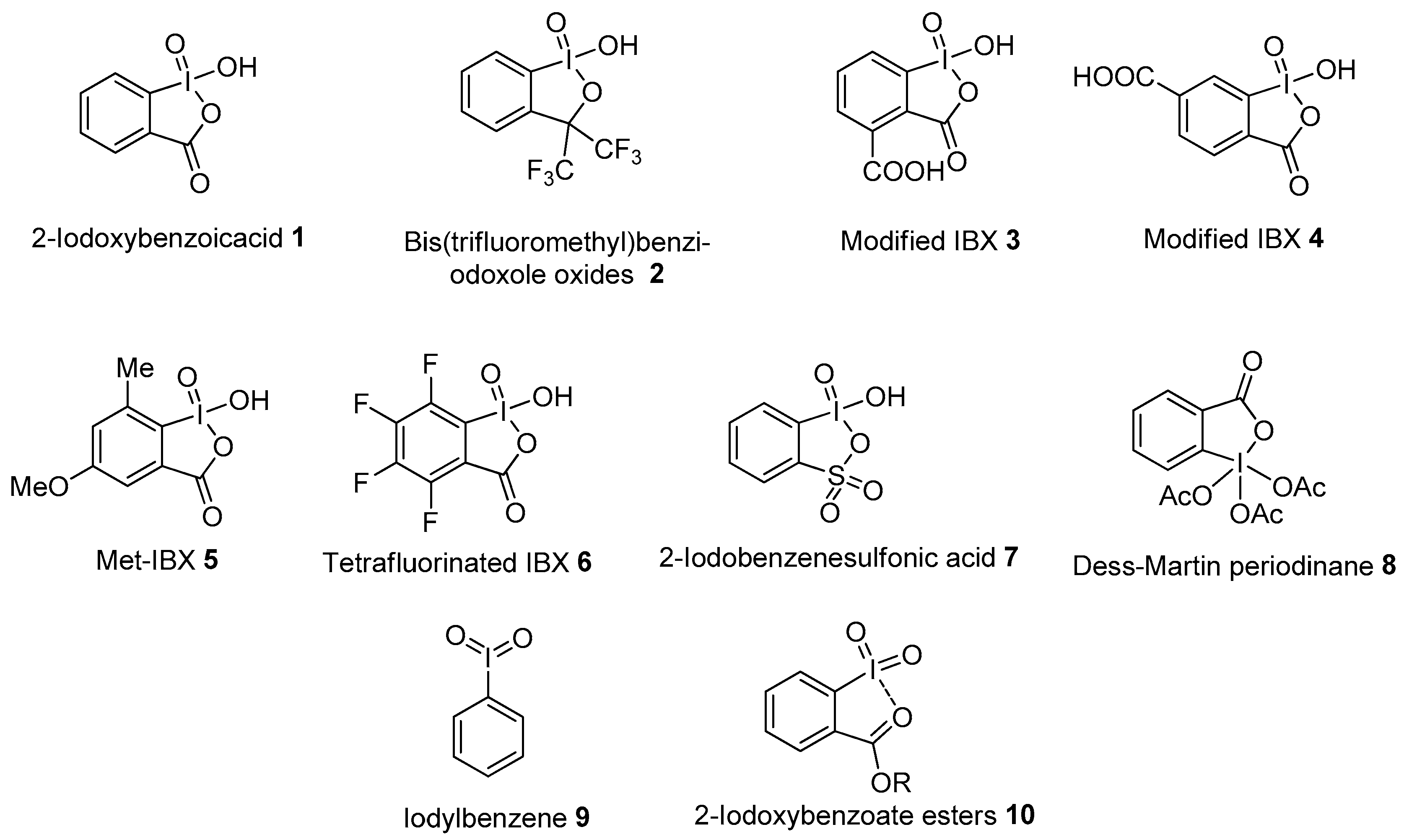
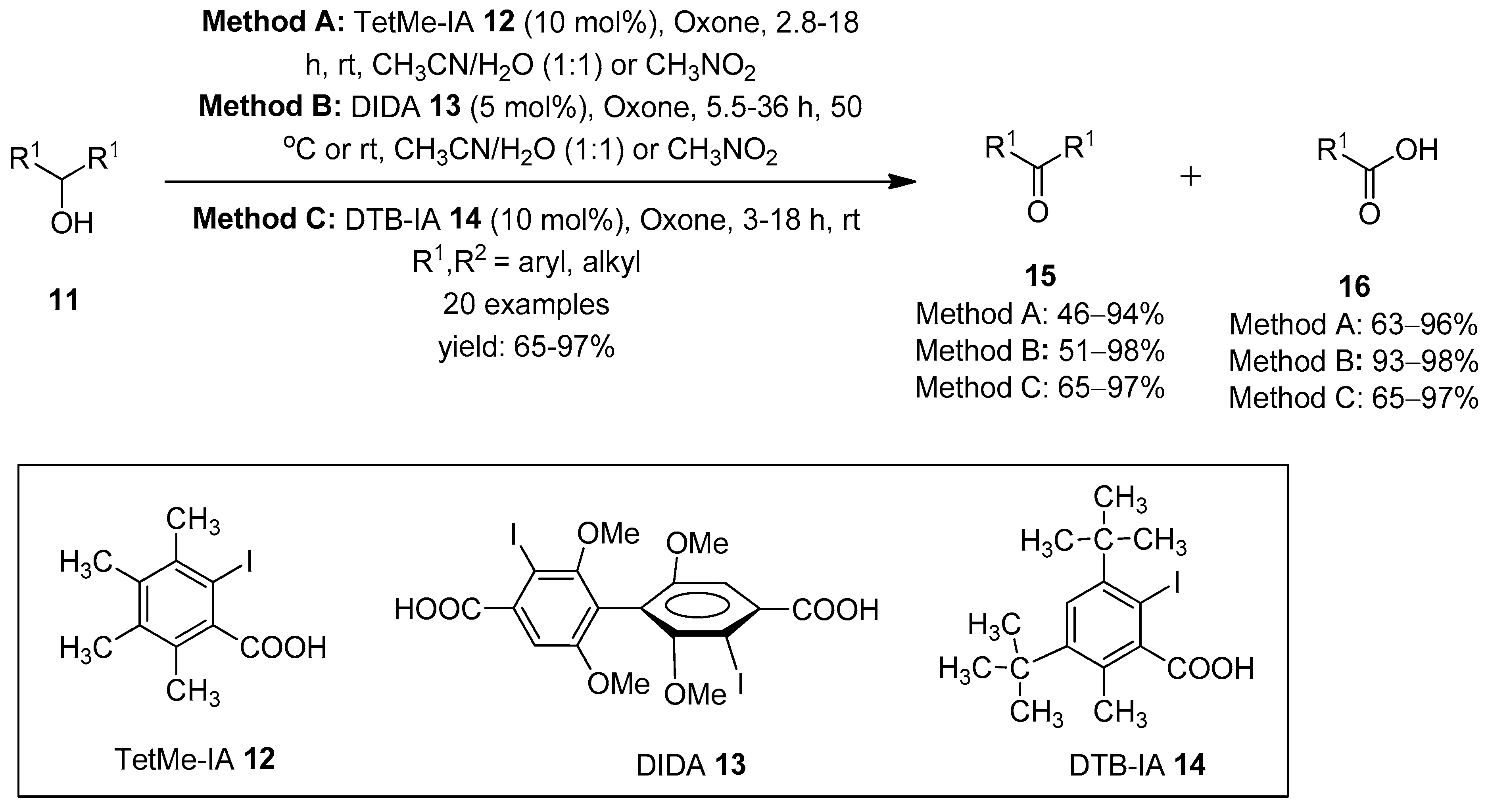
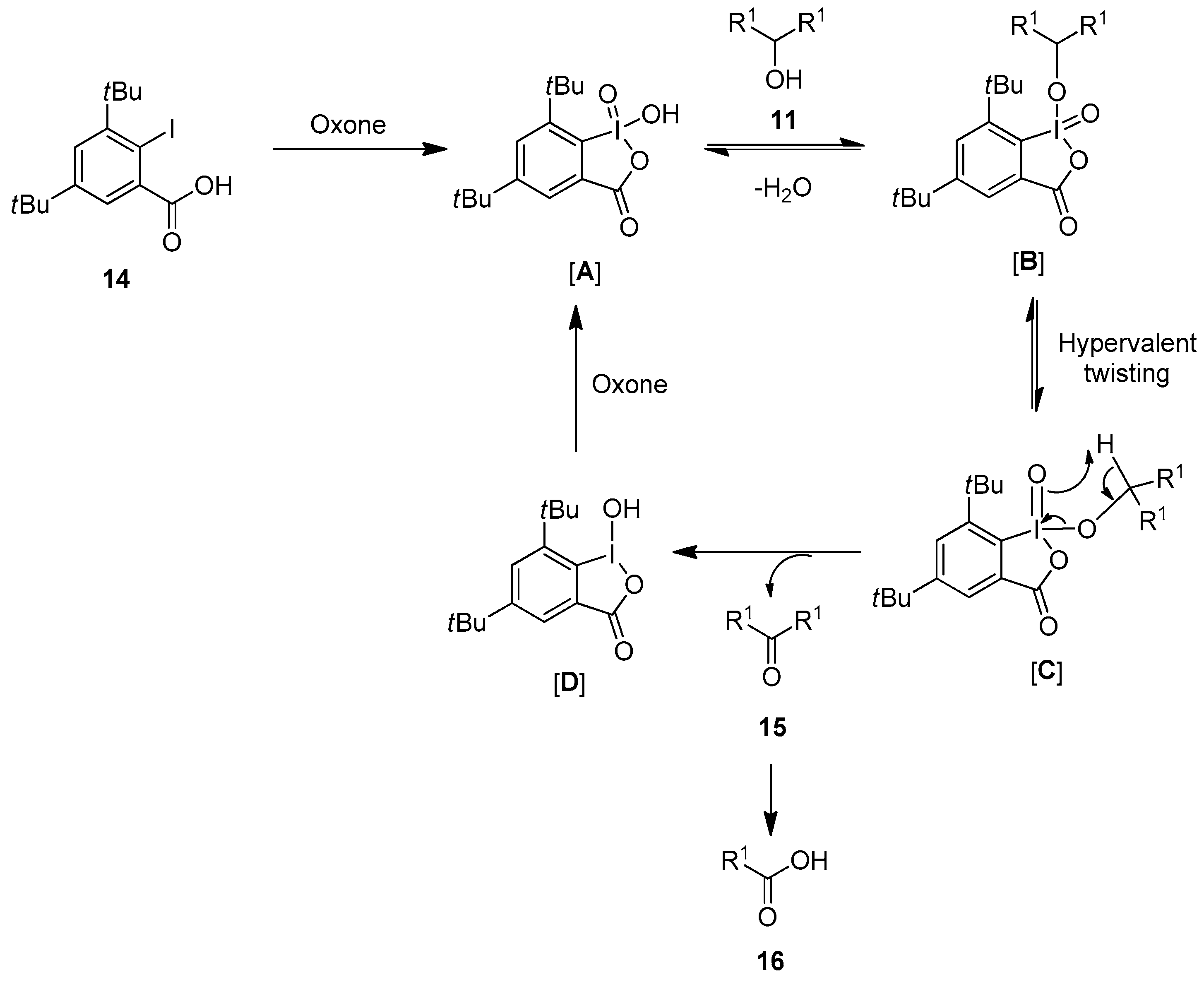



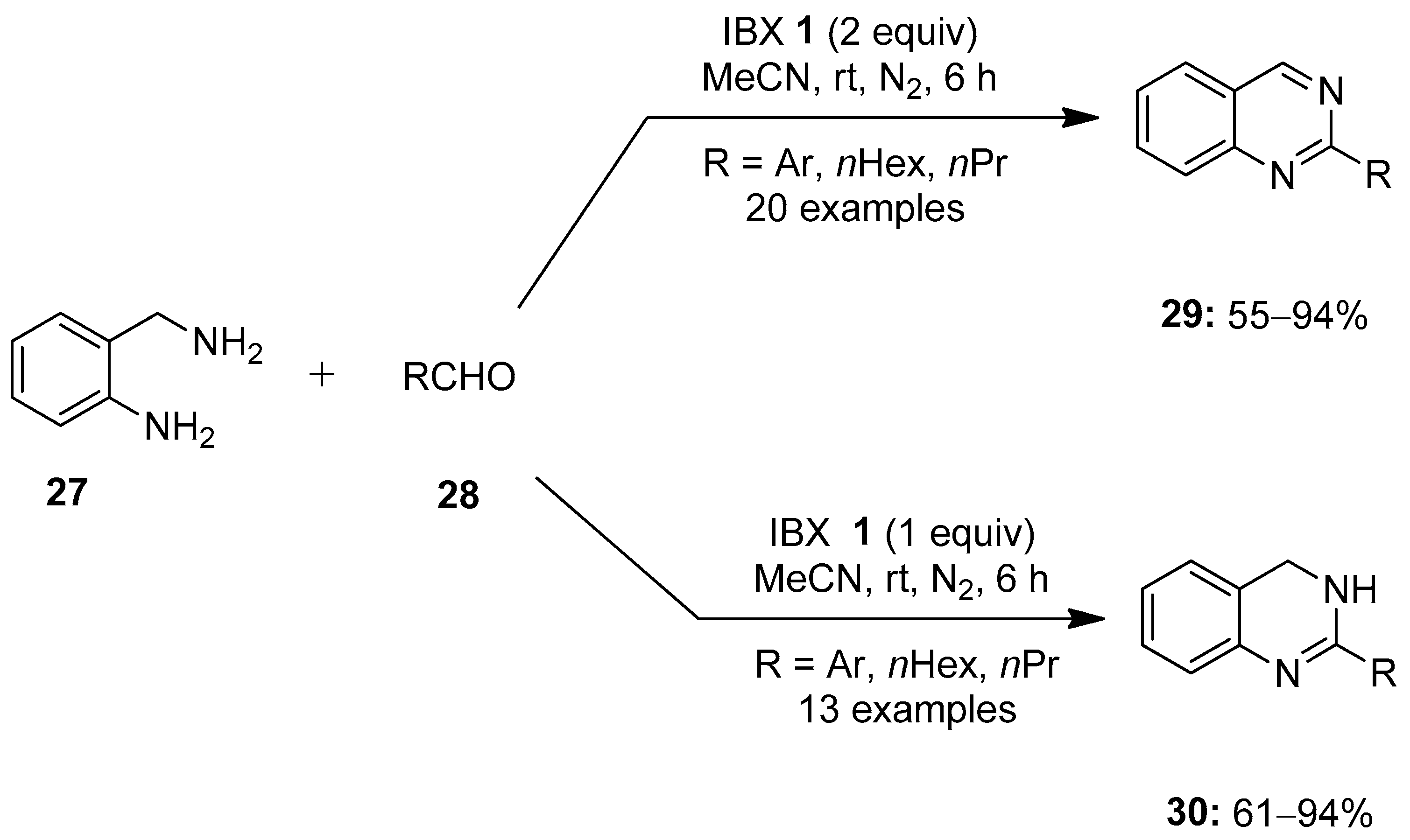
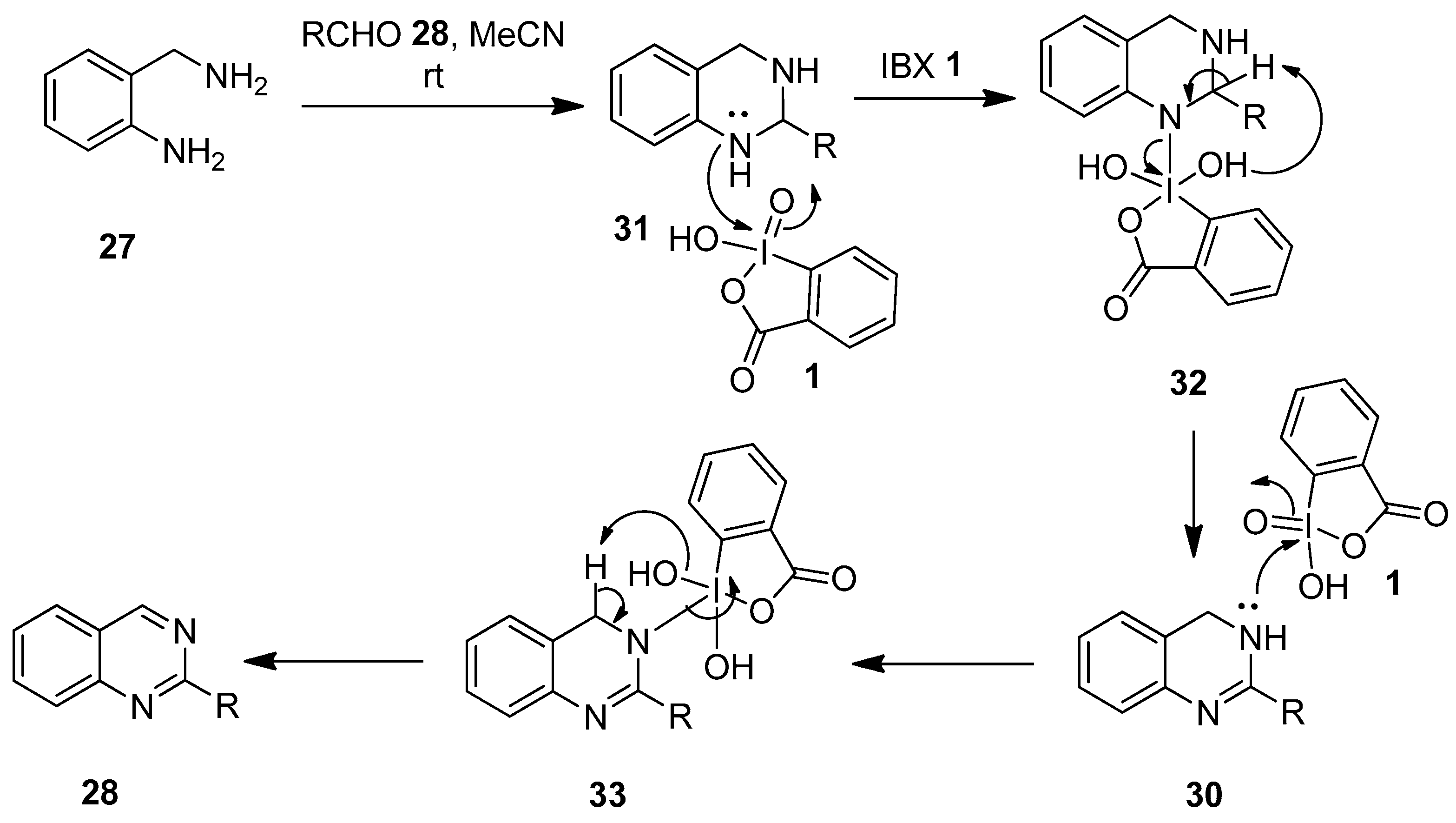
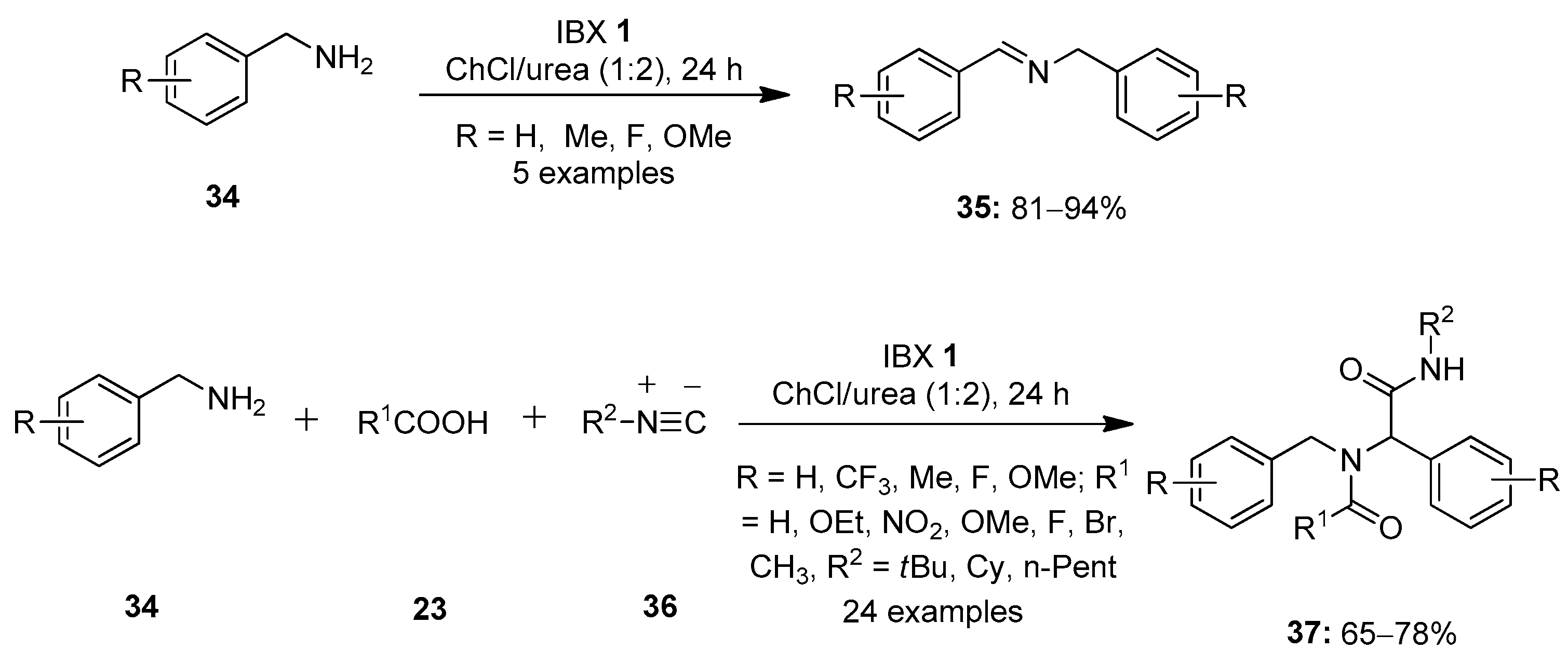


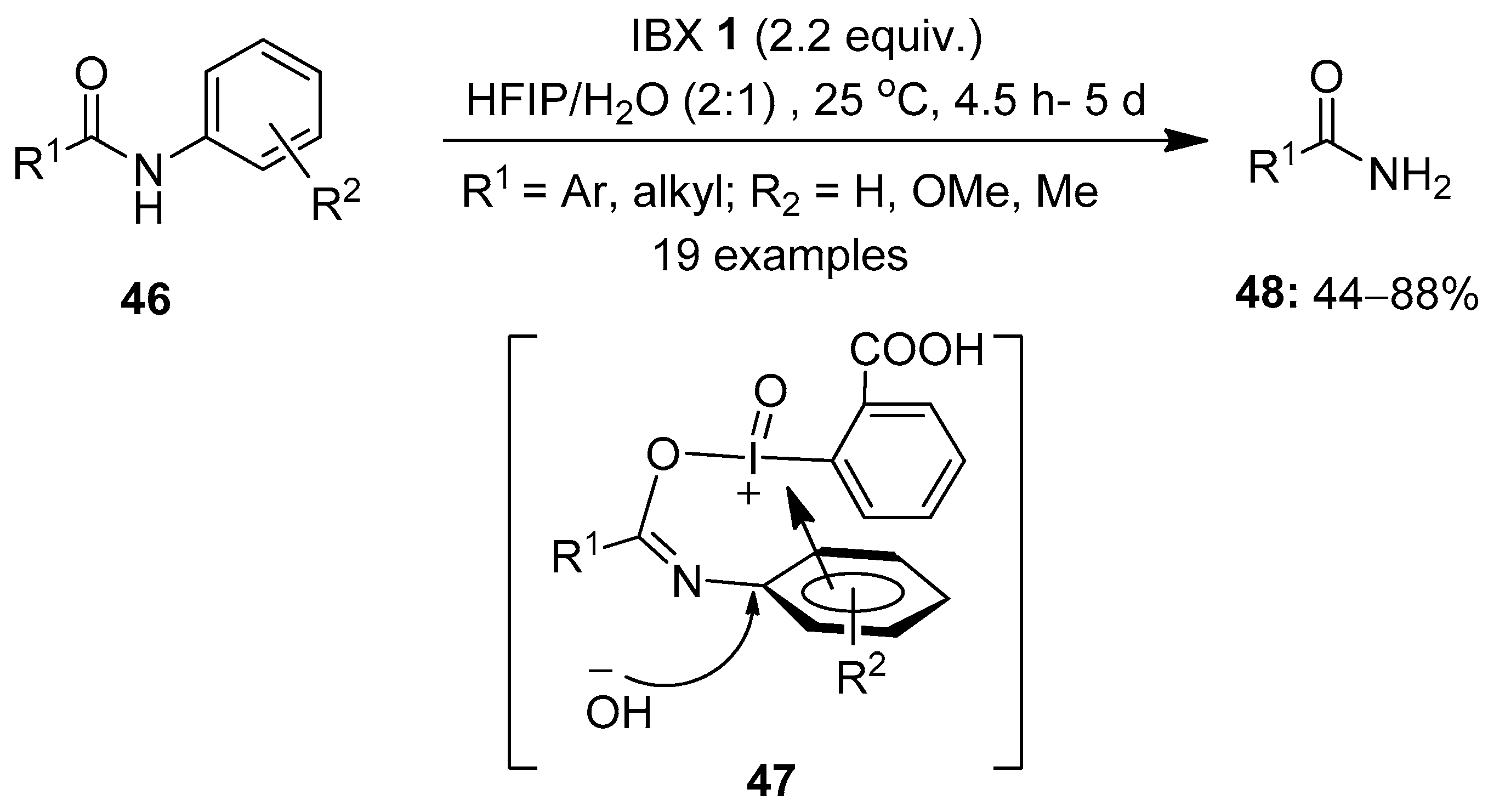


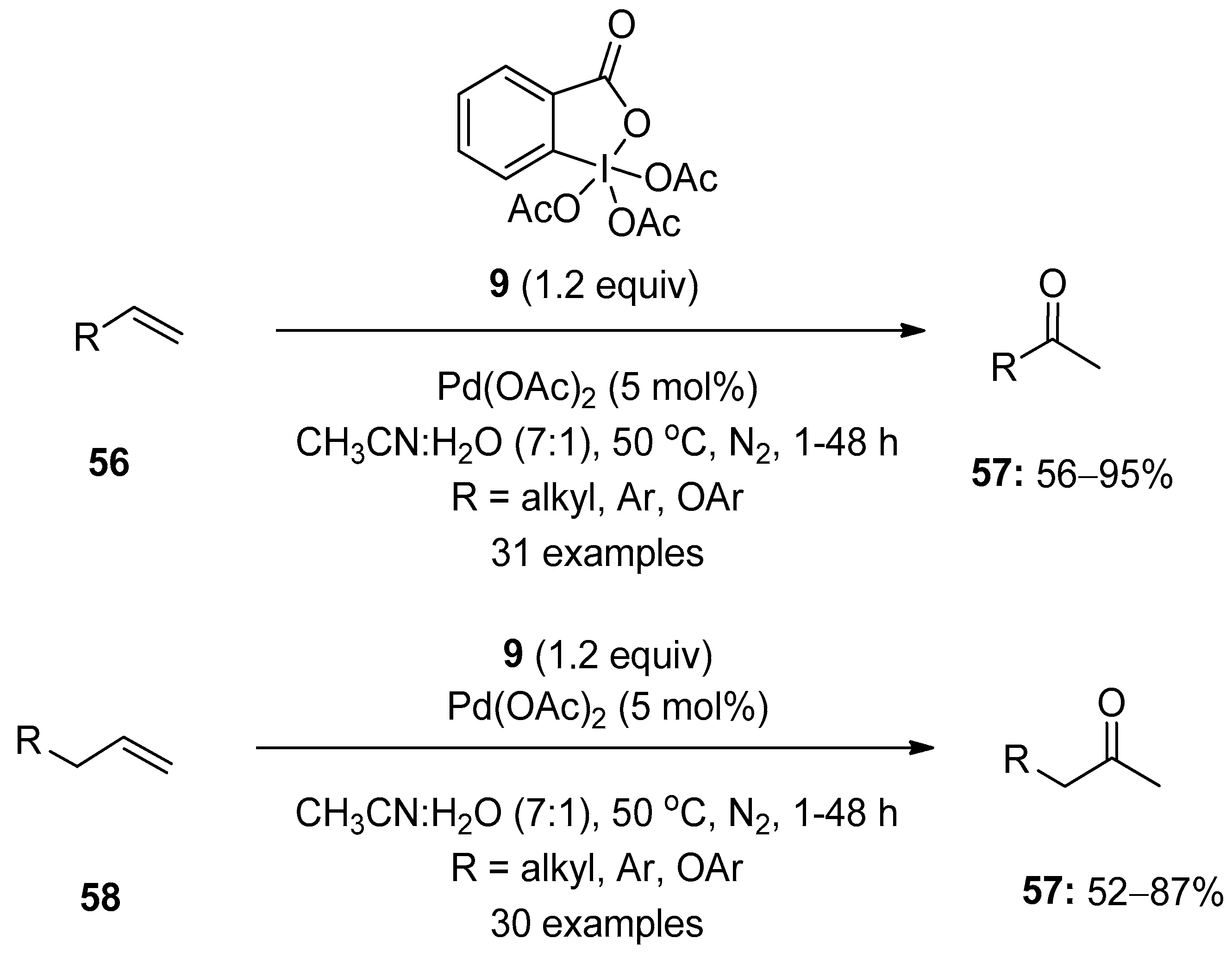
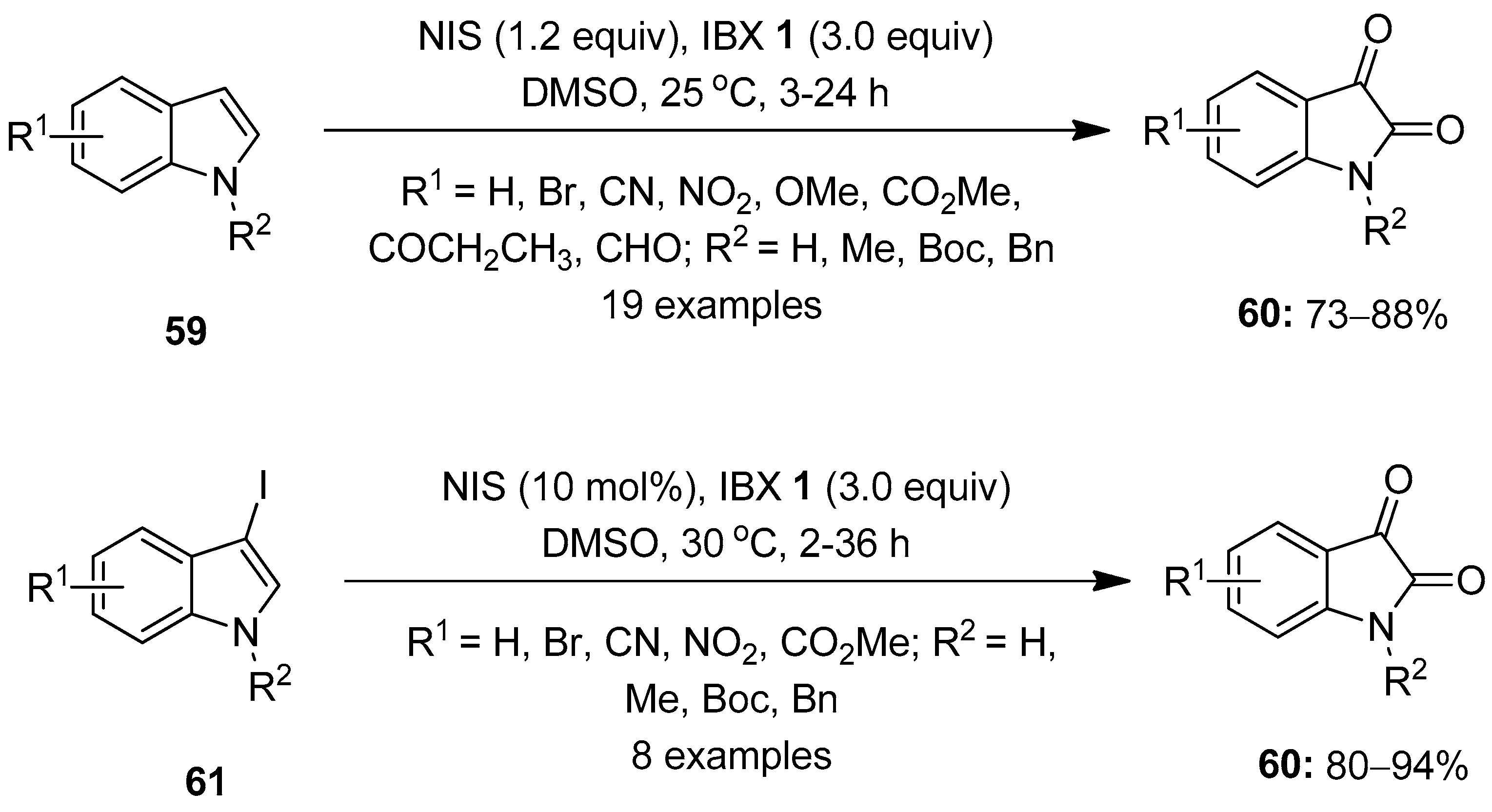
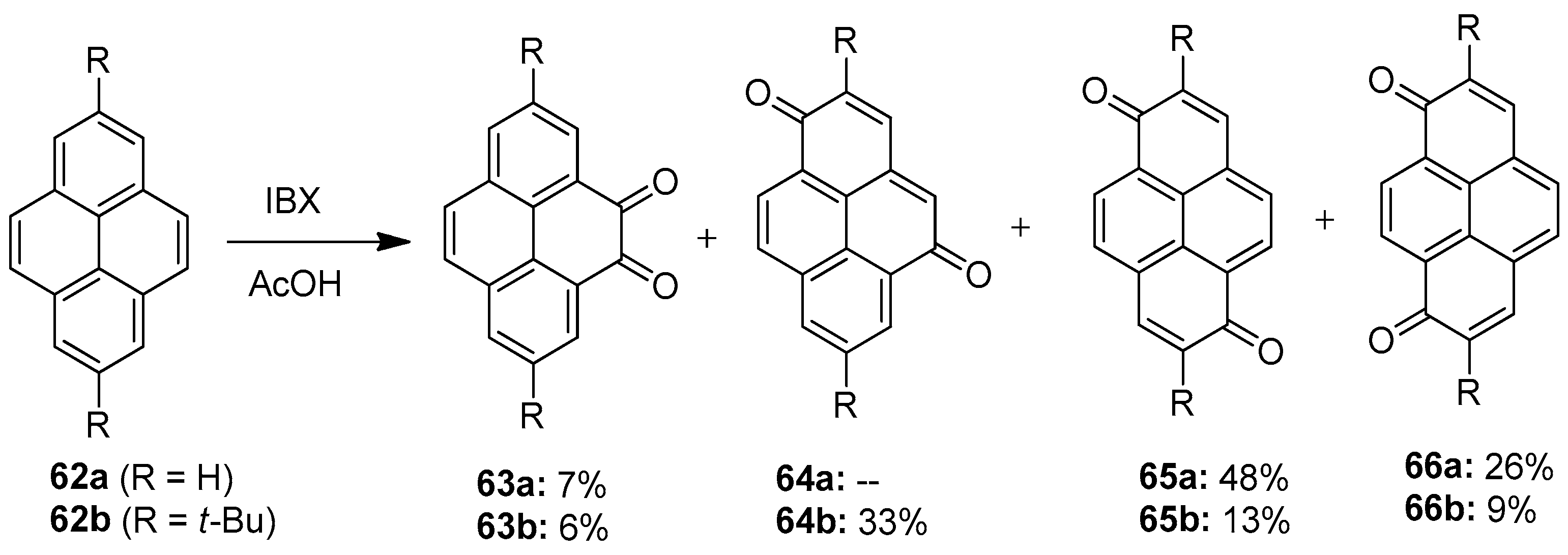
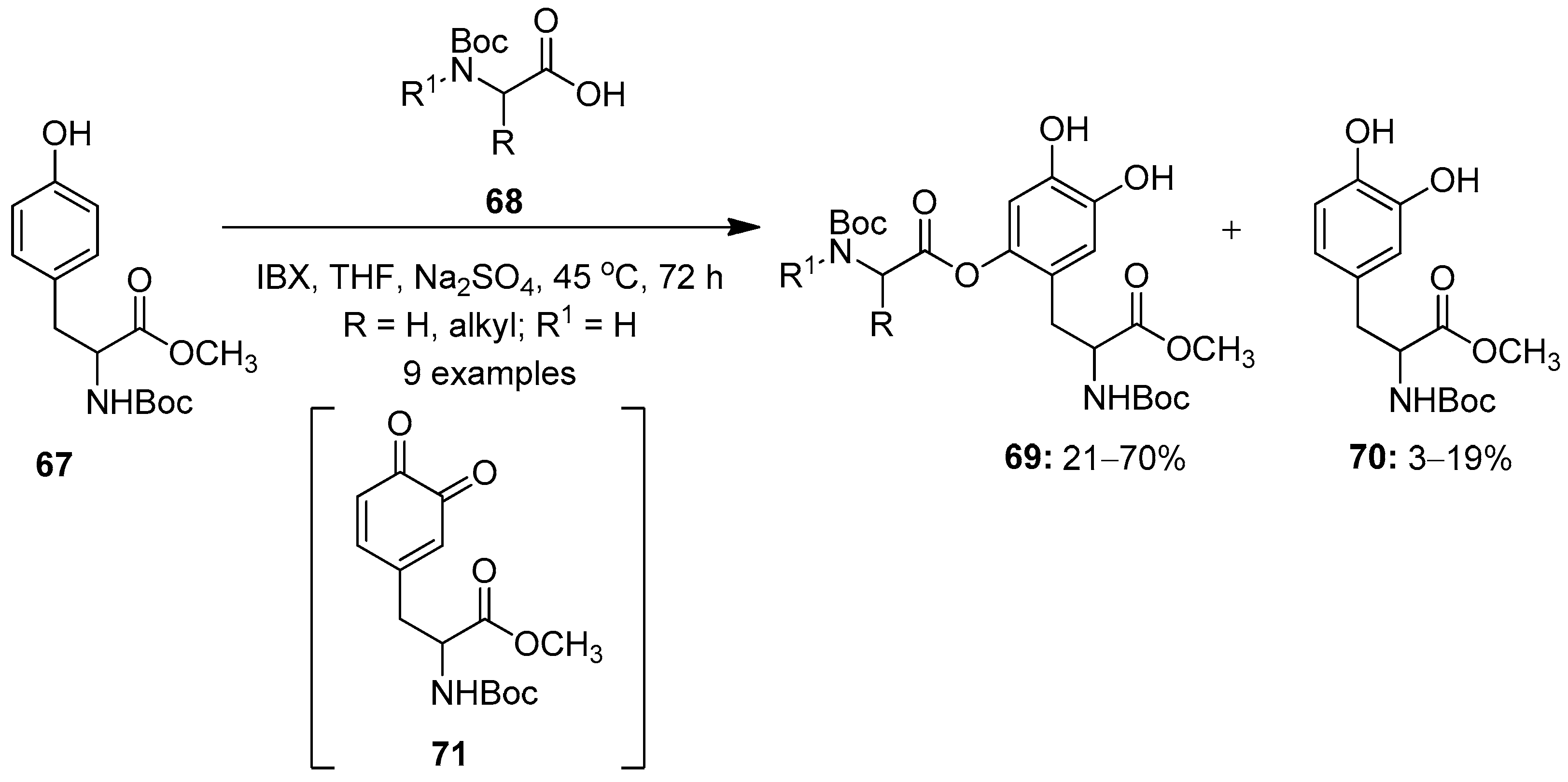
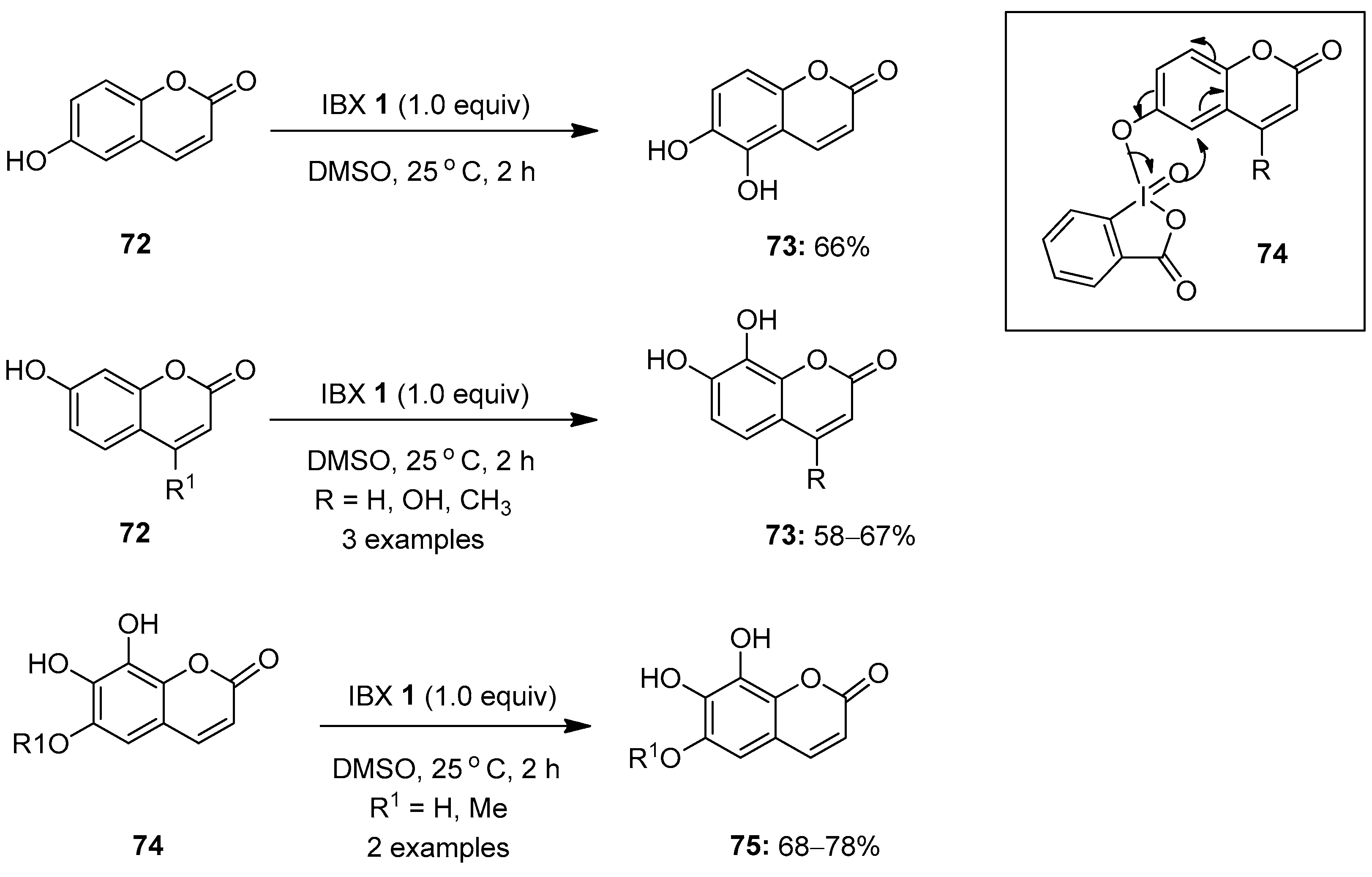
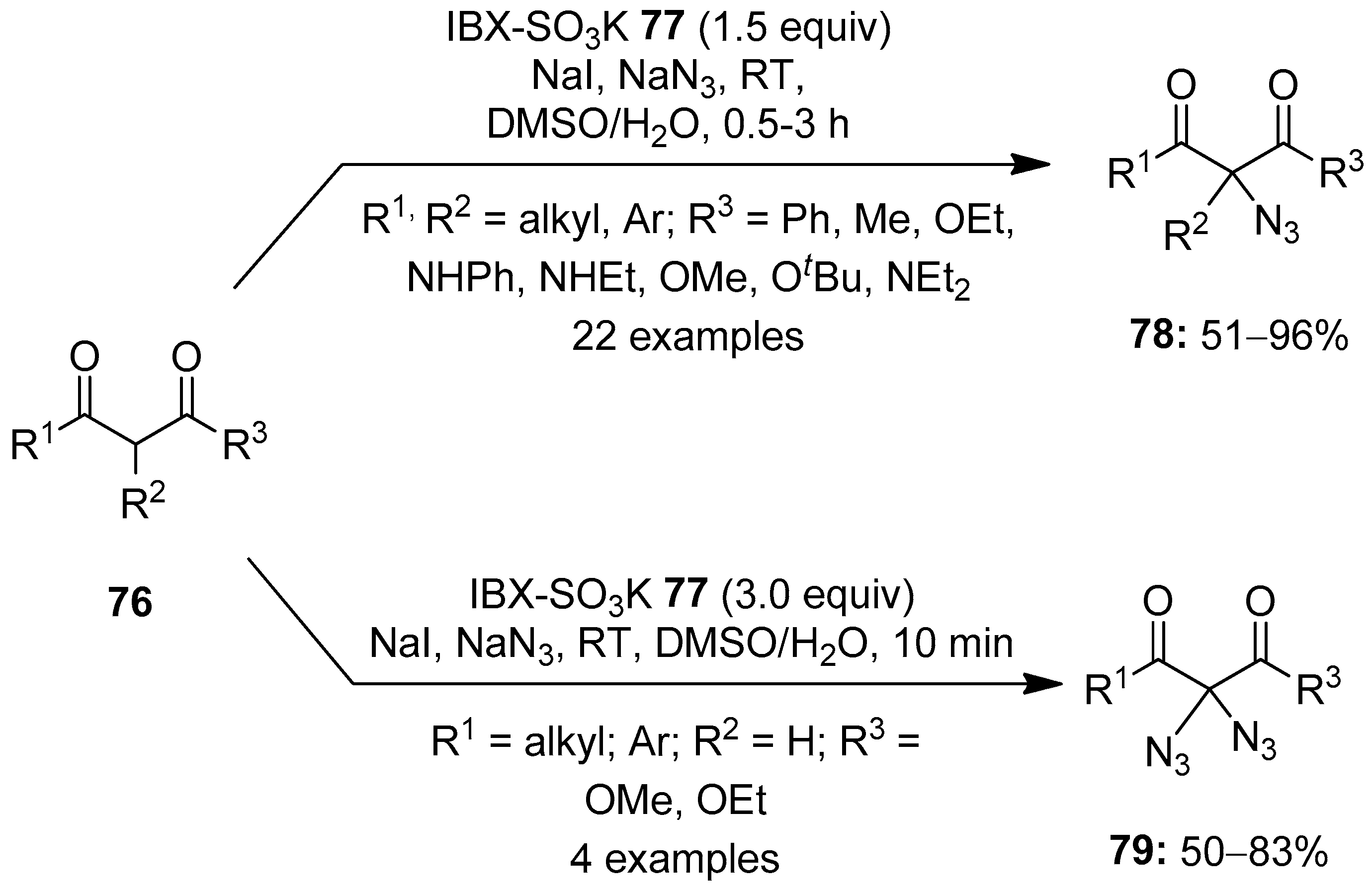

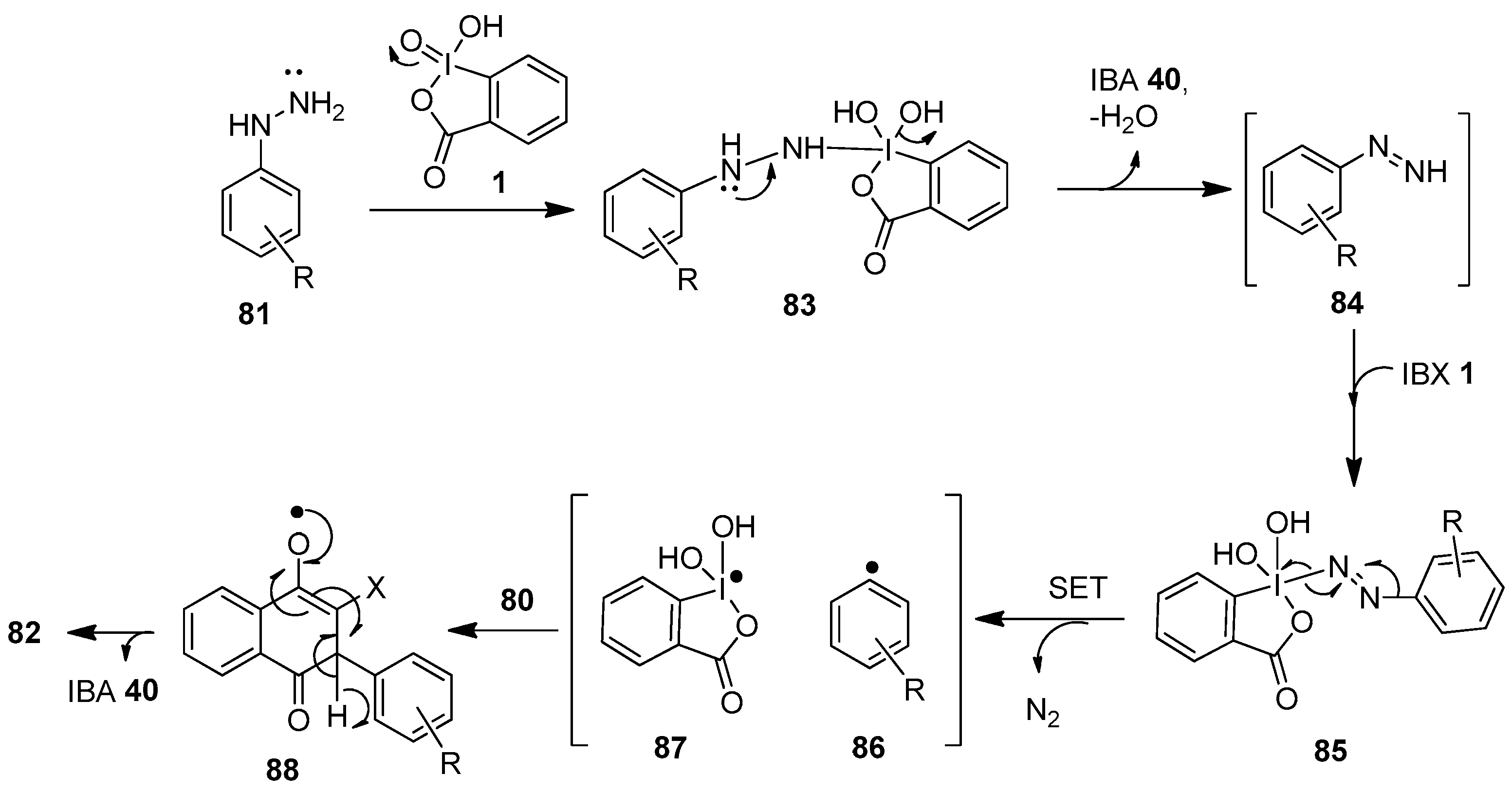
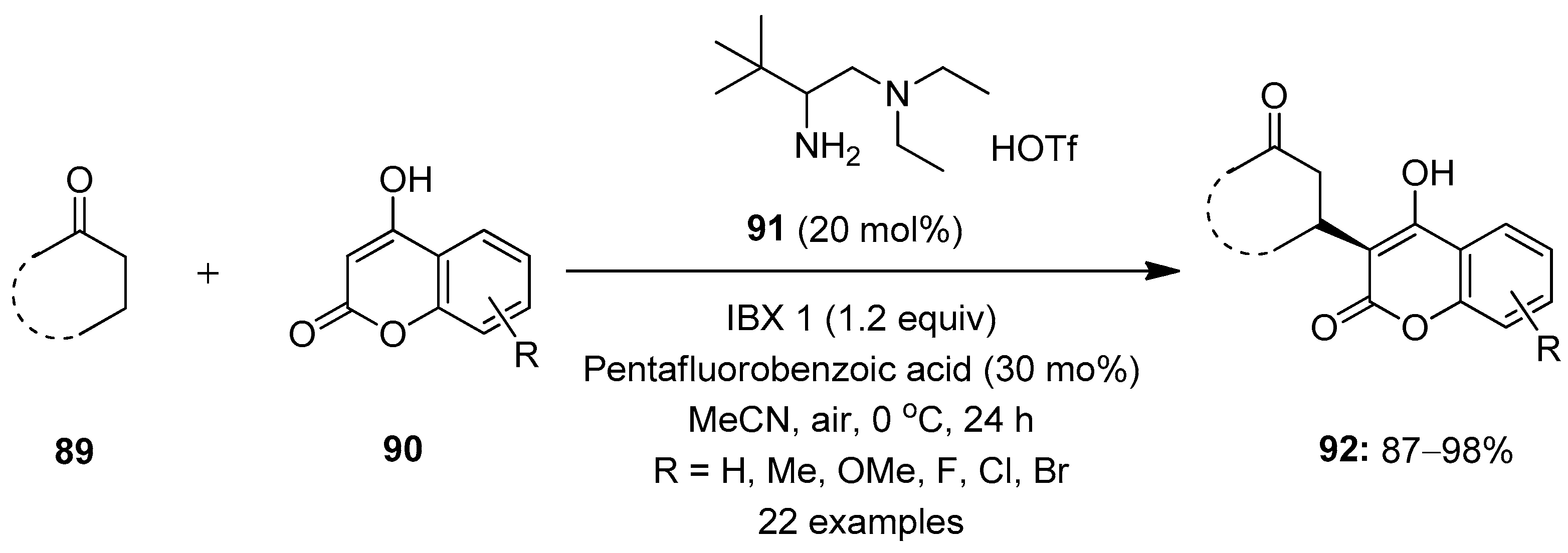
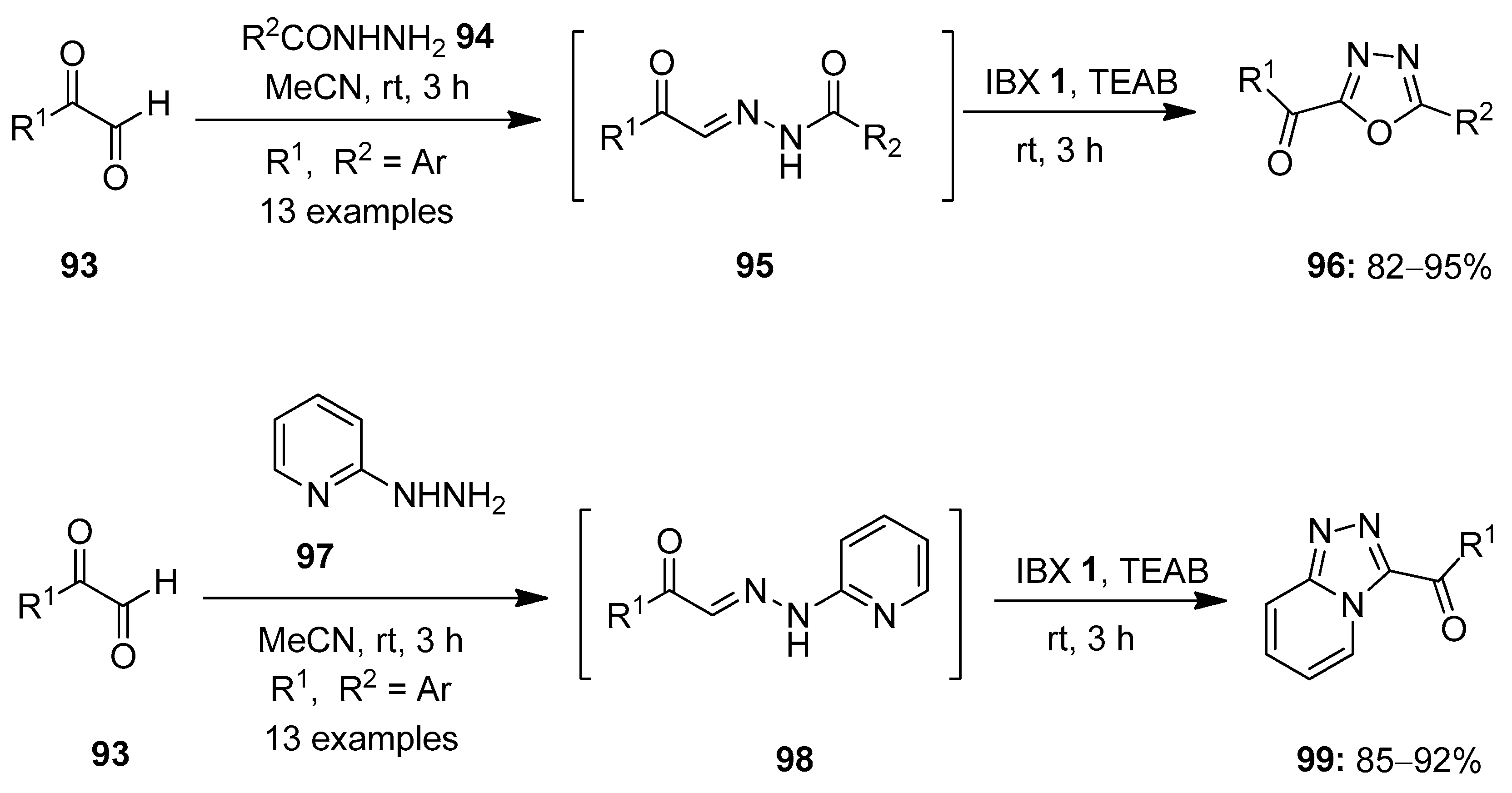
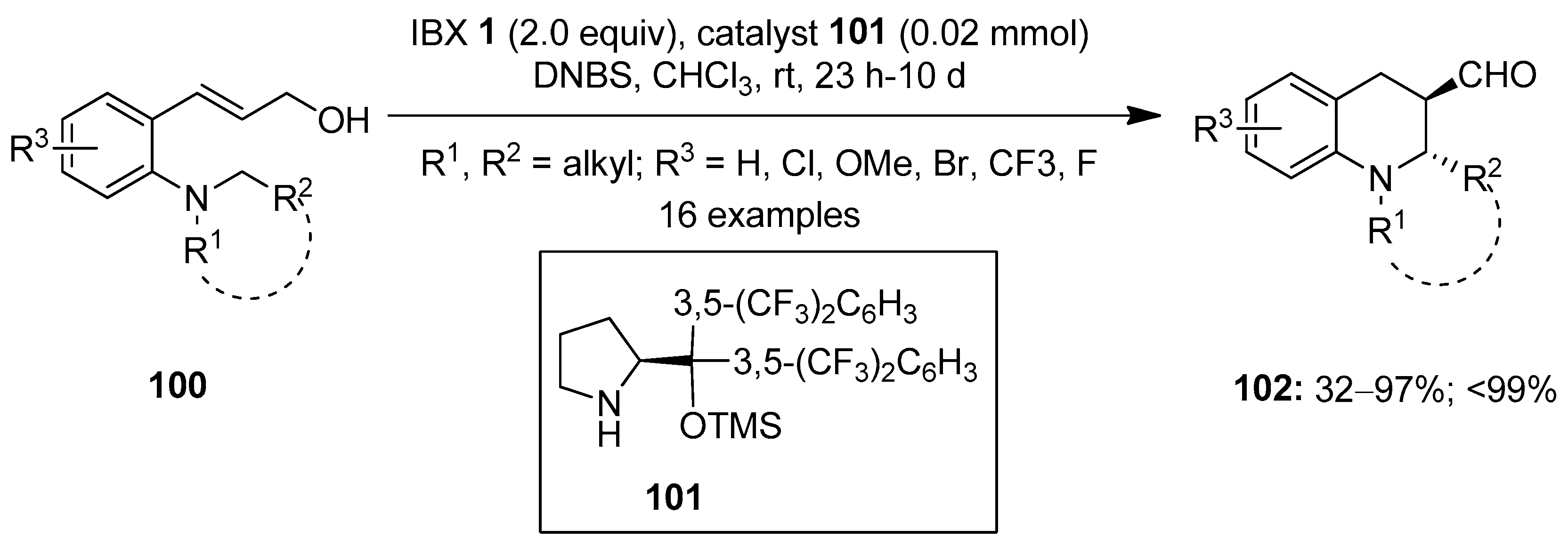
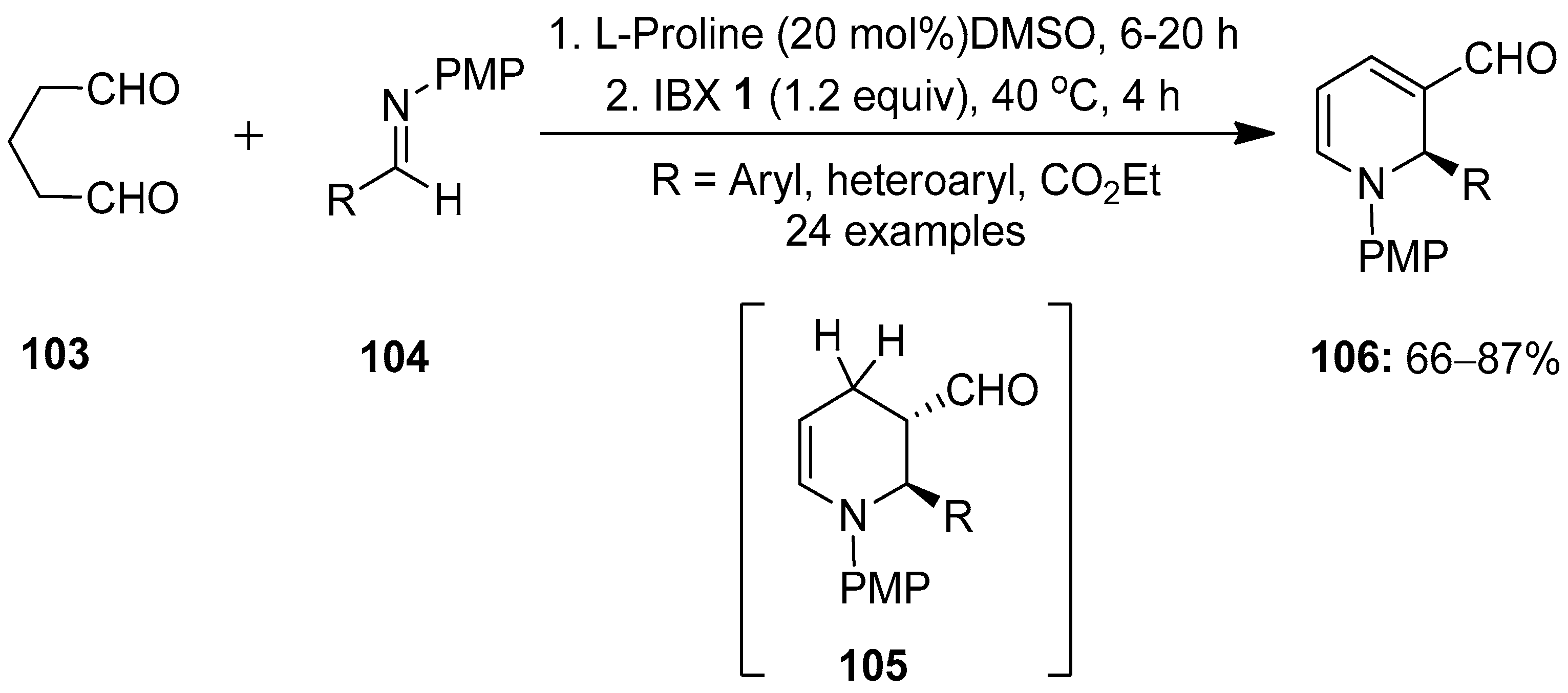


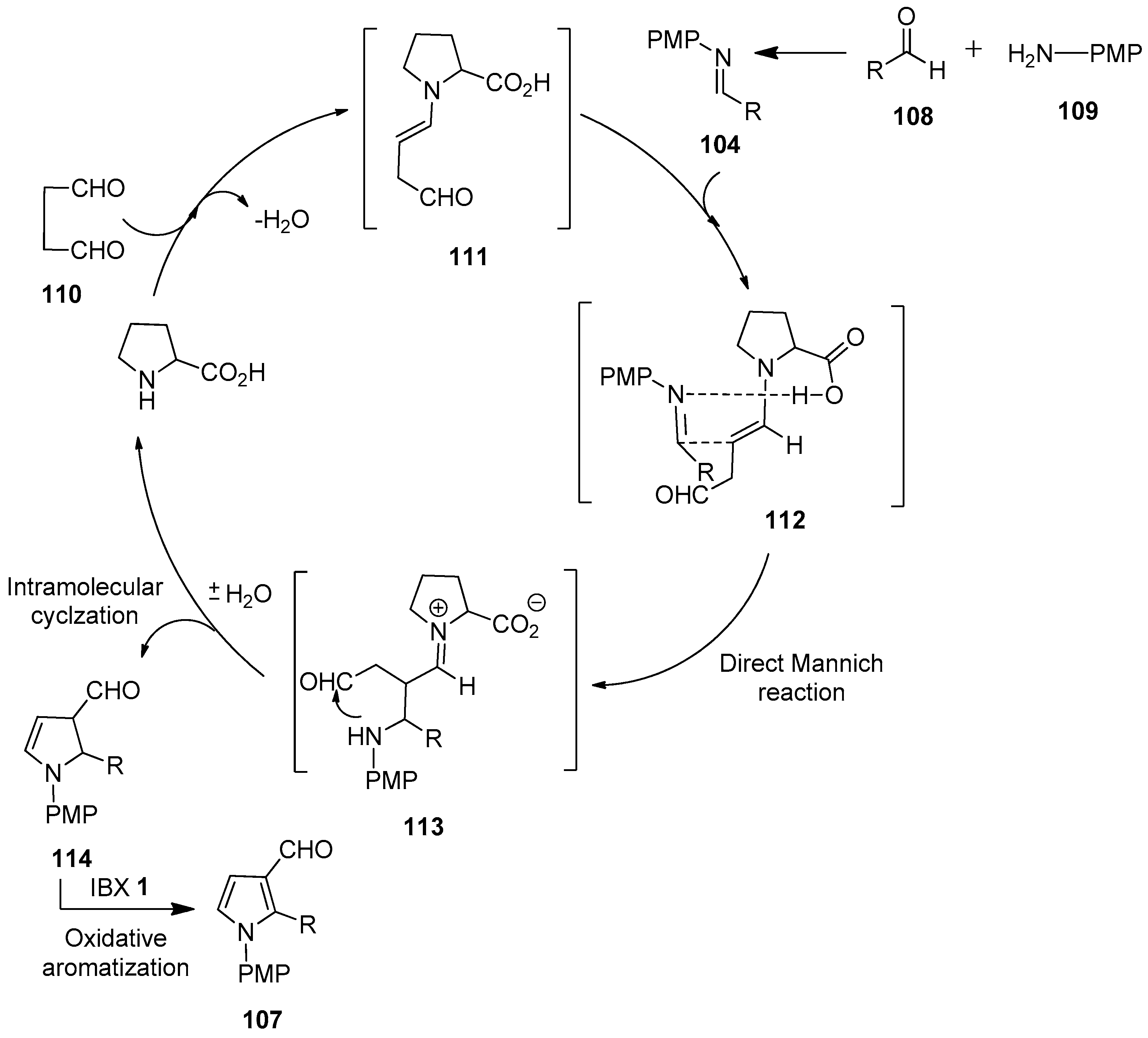

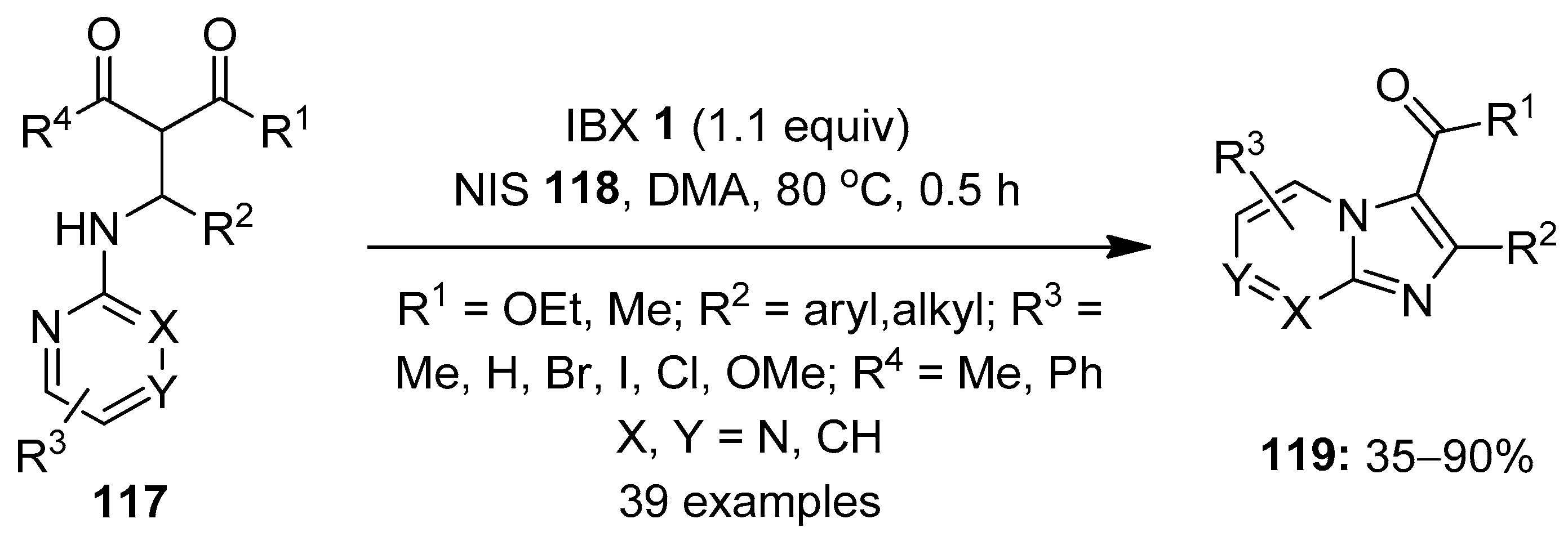
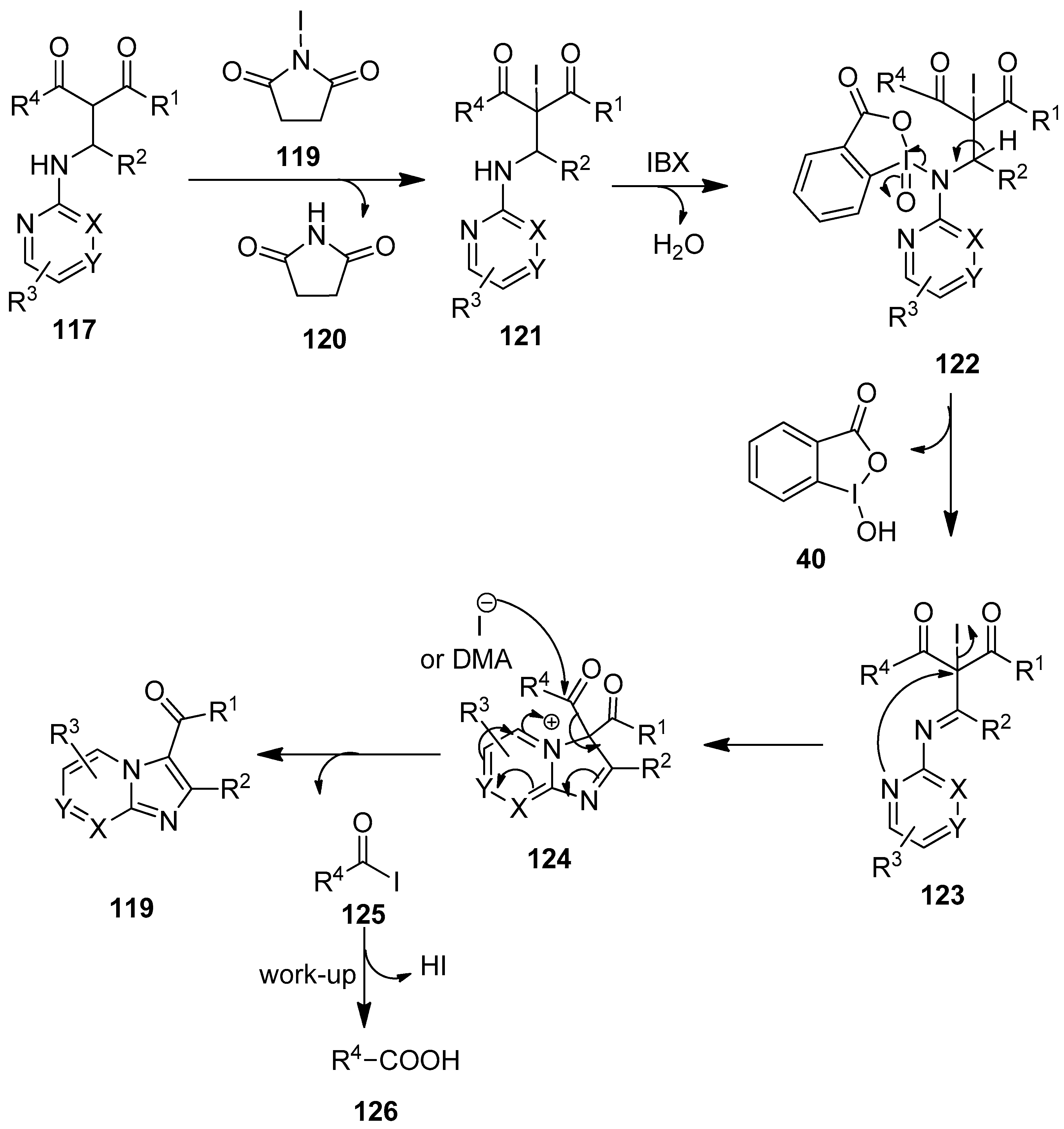

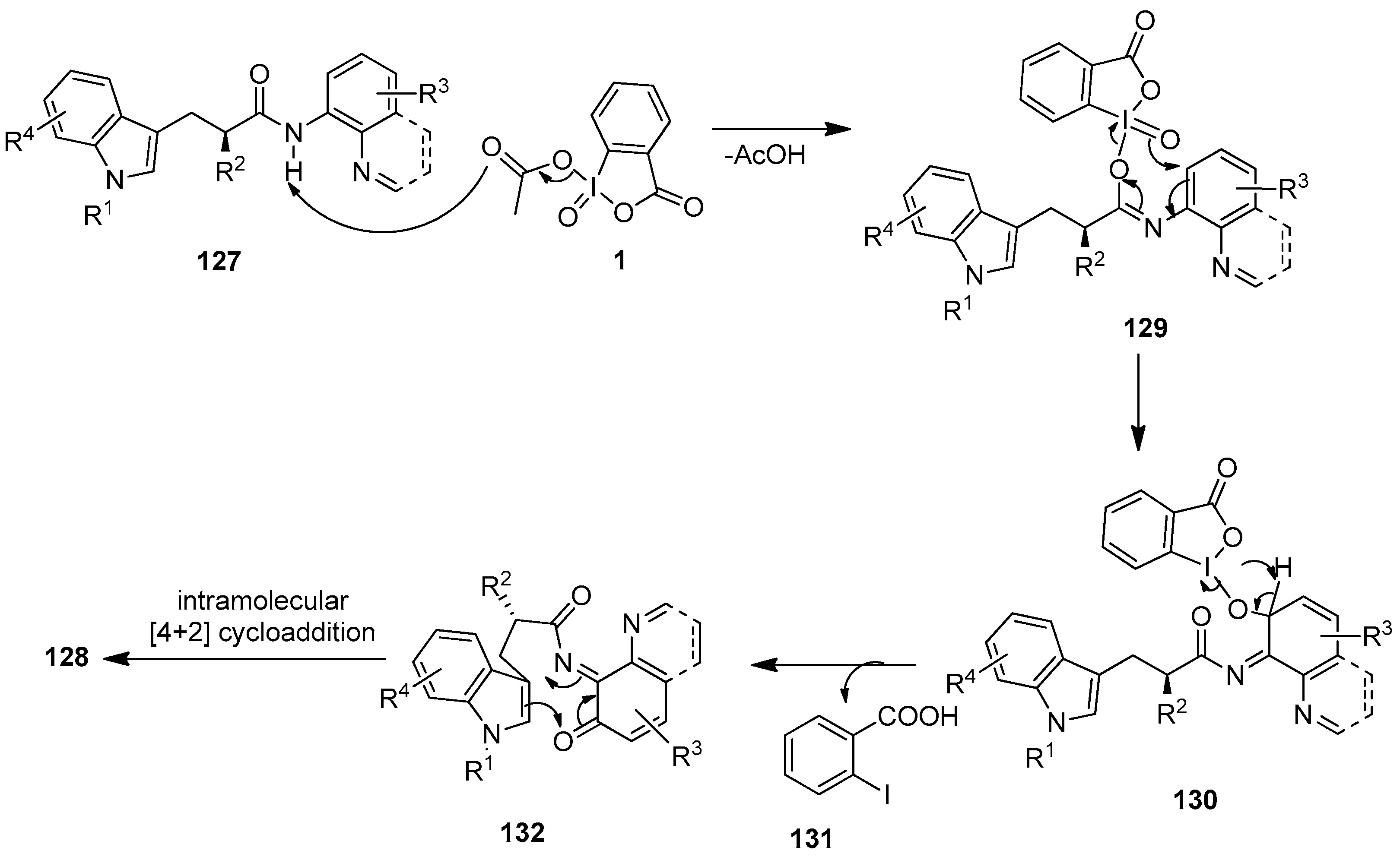
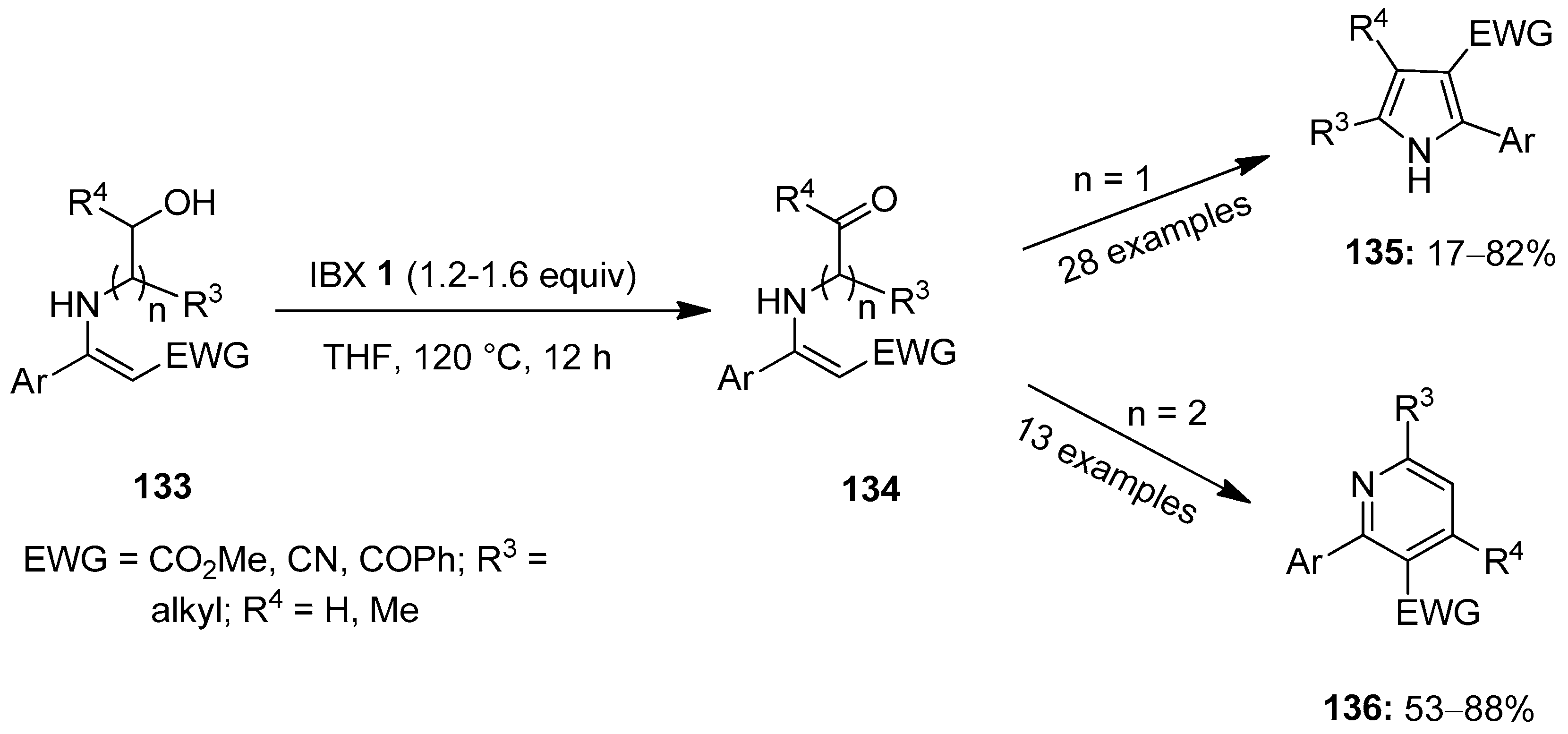

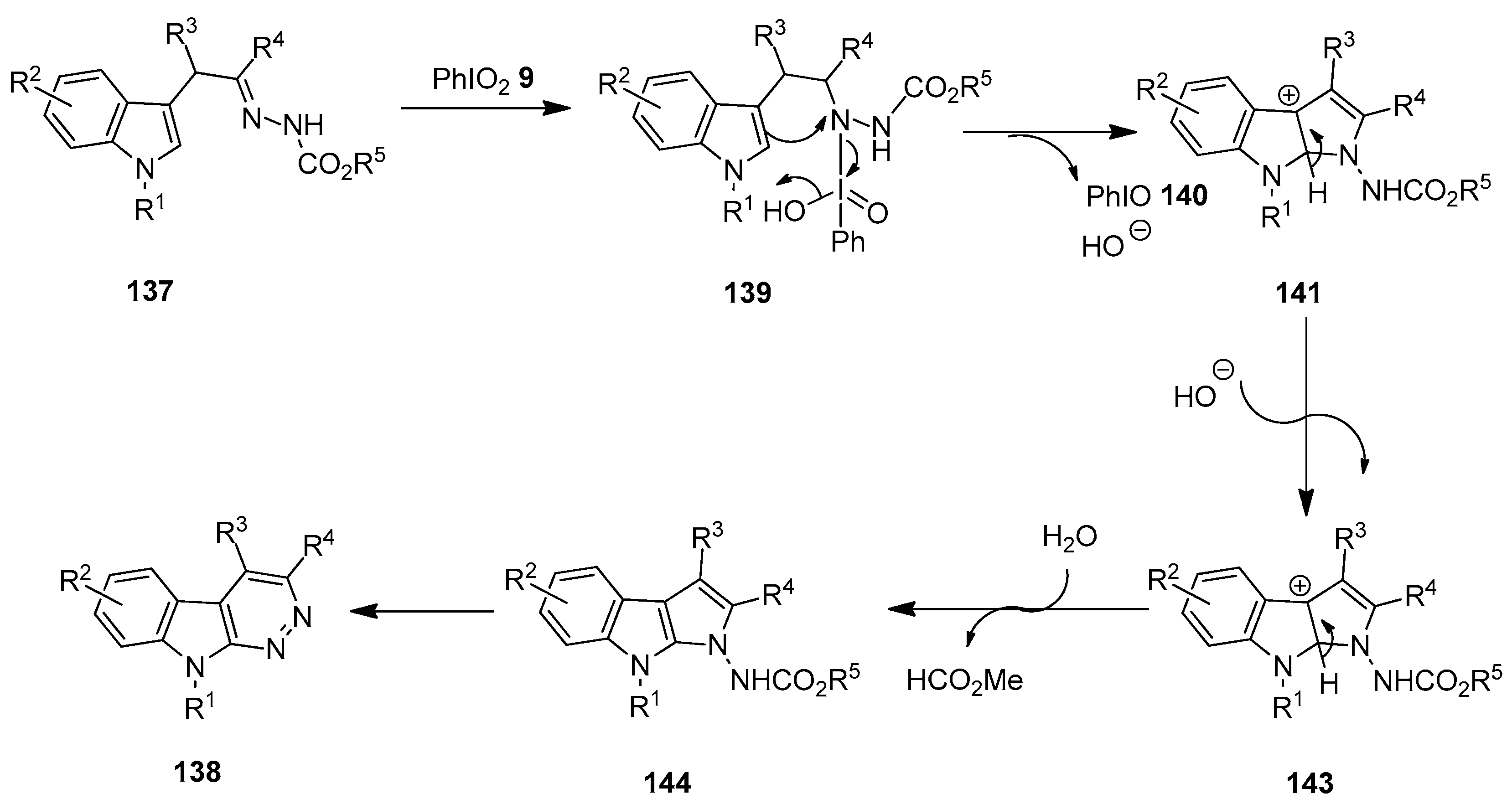

Disclaimer/Publisher’s Note: The statements, opinions and data contained in all publications are solely those of the individual author(s) and contributor(s) and not of MDPI and/or the editor(s). MDPI and/or the editor(s) disclaim responsibility for any injury to people or property resulting from any ideas, methods, instructions or products referred to in the content. |
© 2023 by the authors. Licensee MDPI, Basel, Switzerland. This article is an open access article distributed under the terms and conditions of the Creative Commons Attribution (CC BY) license (https://creativecommons.org/licenses/by/4.0/).
Share and Cite
Shetgaonkar, S.E.; Jothish, S.; Dohi, T.; Singh, F.V. Iodine(V)-Based Oxidants in Oxidation Reactions. Molecules 2023, 28, 5250. https://doi.org/10.3390/molecules28135250
Shetgaonkar SE, Jothish S, Dohi T, Singh FV. Iodine(V)-Based Oxidants in Oxidation Reactions. Molecules. 2023; 28(13):5250. https://doi.org/10.3390/molecules28135250
Chicago/Turabian StyleShetgaonkar, Samata E., Subhiksha Jothish, Toshifumi Dohi, and Fateh V. Singh. 2023. "Iodine(V)-Based Oxidants in Oxidation Reactions" Molecules 28, no. 13: 5250. https://doi.org/10.3390/molecules28135250
APA StyleShetgaonkar, S. E., Jothish, S., Dohi, T., & Singh, F. V. (2023). Iodine(V)-Based Oxidants in Oxidation Reactions. Molecules, 28(13), 5250. https://doi.org/10.3390/molecules28135250








